

Please verify you are a human
Access to this page has been denied because we believe you are using automation tools to browse the website.
This may happen as a result of the following:
- Javascript is disabled or blocked by an extension (ad blockers for example)
- Your browser does not support cookies
Please make sure that Javascript and cookies are enabled on your browser and that you are not blocking them from loading.
Reference ID: 365eeaae-6392-11ef-b3a0-3c4978cd7b63
Powered by PerimeterX , Inc.
Boat Navigation Lights Rules: Illustrated Beginners Guide
When navigating at night, the lights on other boats are your first clue about the moving dangers around you. And your navigation lights are your first line of safety in avoiding collisions in the dark, and they tell others vessels what you are and what you are doing. The rules sound complex, but with a little understanding you can get the basics for any situation.
So what are the basic navigation light rules? For most small vessels, motoring requires red and green (port and starboard) lights, and a white light visible in all directions around the boat. This is almost always a stern light and a masthead light on sailboats. Boats under sail require port and starboard lights, and a white stern light. Sailboats below sixty-five feet may show a tricolor light at the masthead instead of side and stern lights when sailing.
That's it, in a nutshell. There's a little more to it, as the rules change with different sizes and there are some specifics about angles of display for the colors. Identifying other ships at sea requires more study, but the basics are the same. And it's not much trouble to make sure you've always got the proper lights on your vessel.
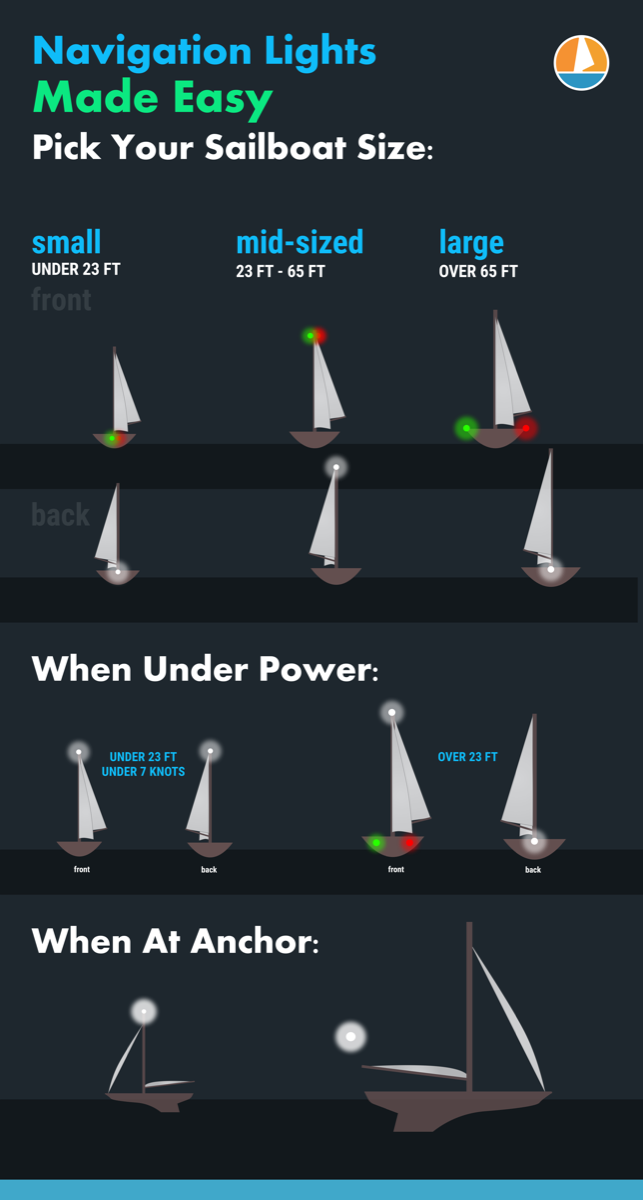
On this page:
What are the official colregs rules for your sailboat, what about the uscg (united states coast guard) rules, lighting at anchor, identifying the boats around you.
The International Regulations for the Prevention of Collision at Sea , abbreviated "COLREGS" is very specific about the lights required, their shapes and sizes, and the distance they must be visible. For the smaller boat, the following definitions apply.
- Masthead Light - a white light placed centerline on the boat showing an arc of 225 degrees with 112.5 degrees either side of the front of the vessel.
- Sidelights - A red light on the port side and a green light on the starboard. They must show an arc of 112.5 degrees from centerline of the bow.
- Stern light - A white light on the stern of the boat showing an unbroken arc of 135 degrees from centerline of the vessel.
- All-round light - A light showing in an unbroken arc of 360 degrees.
The good news is you need not measure these angles. Any properly installed USCG or COLREGS approved light which will cover the correct arcs. If you have to replace the original light from your boat, make sure it's with an approved replacement.
Lights When Sailing
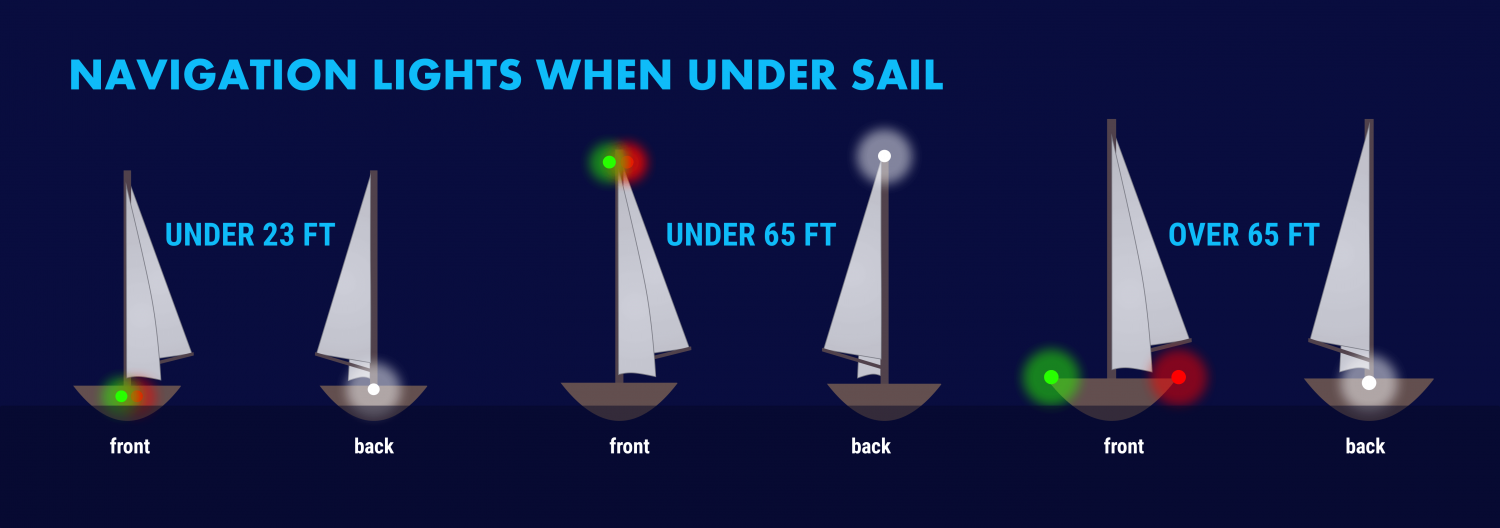
The specific rules for a sailboat under sail are in COLREGS Rule 25 and vary slightly with the size of the boat. A sailboat powering is considered a power boat and falls under in Rule 23.
- Under 23 feet (7 meters) - side lights and a stern light, possible. If these lights can not be displayed a light must be kept at hand to help avoid a collision. This can be a bright flashlight.
- Over 23 feet - Side lights visible to one nautical mile and stern light visible for two.
- Vessels under 65 feet may combine both sidelights into a single lantern on the bow.
- May show a tricolor light on the masthead instead of sidelights and a stern light. It's one or the other though, do not show these lights at the same time .
- Masthead light must be visible for three nautical miles, all other lights must have a two nautical mile visibility.
- Side lights must be separated.
- May not show a masthead tricolor light.
- Masthead light must have five nautical mile visibility, all other lights must be visible for two nautical miles.
- Optional masthead lights - any vessel under sail may display a red light over a green light at the masthead with sidelights and stern light. The red over green may NOT be displayed with a masthead tricolor light. It's one set or the other.
Lights When Motoring
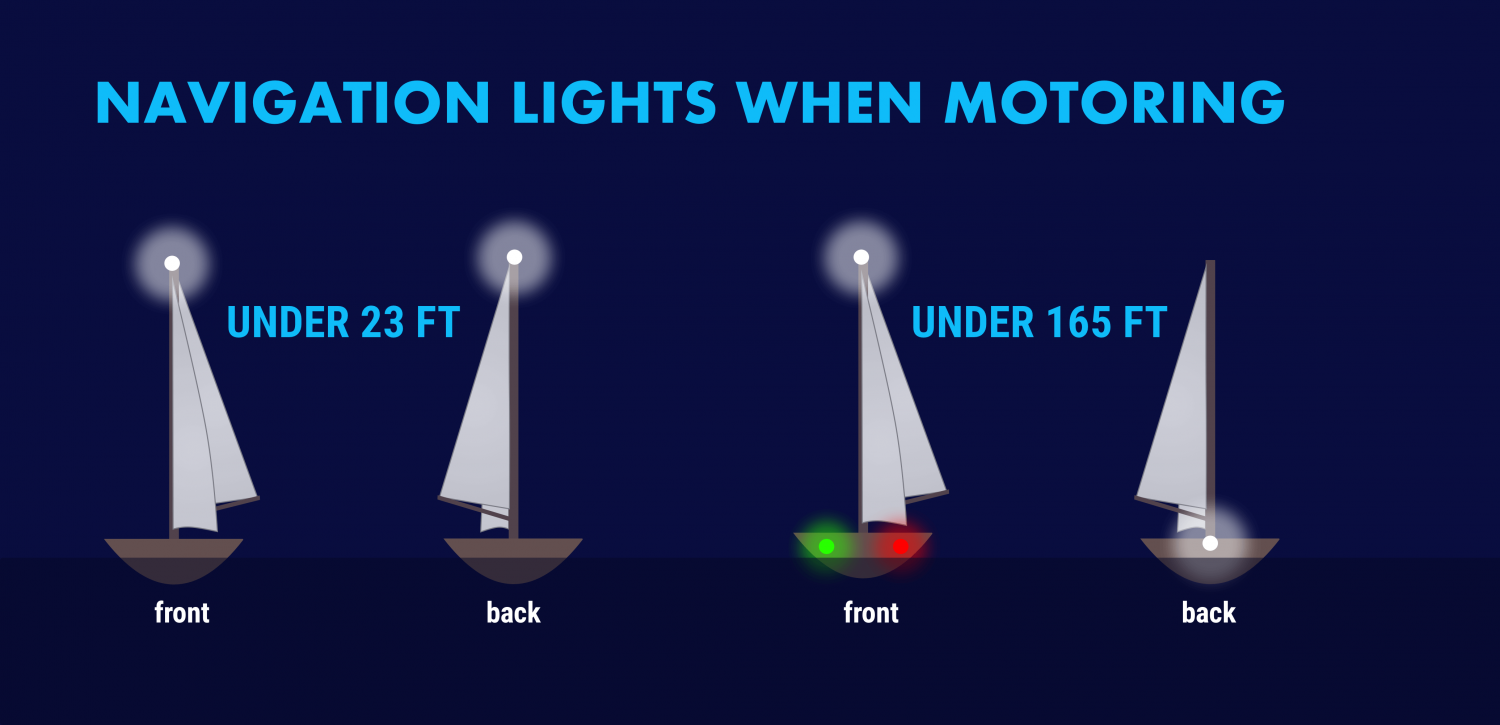
For all navigational purposes a sailboat under power is considered a power boat. This includes motor sailing - if the engine is on and providing propulsion you are on a power boat, even if the sails are up . This applies to navigation lighting, sound signals in fog and limited visibility, and rights of way.
Sailboats under 50 meters under power need to show:
- A masthead light
- Stern light
A power-driven vessel under 23 feet (7 meters) that does not exceed seven knots of speed may display an all around white light, though sidelights should be used if available.

The USCG has published its own "Rules of the Road" that are based on the COLREGS. In addition, it has rules for the "Inland Waterways" for rivers, inland lakes and the Great Lakes.
The good news is this has no impact on what you have to do with your own boat.
They mostly relate to lighting changes on towed vessels like barges and tugs. For example, a vessel towing or pushing another vessel in the ocean under COLREGS shows two masthead lights, sidelights and a stern light, whereas in Inland Waterways the towing or pushing vessel displays two yellow towing lights instead of a white stern light.
If you sail on lakes, rivers or the Great Lakes where towed commercial traffic is common you should learn the inland lights, but coastal or ocean sailors will never see these.
When you anchor outside a designated mooring field, you should display an all around white light at the masthead or as high in the boat as practical.
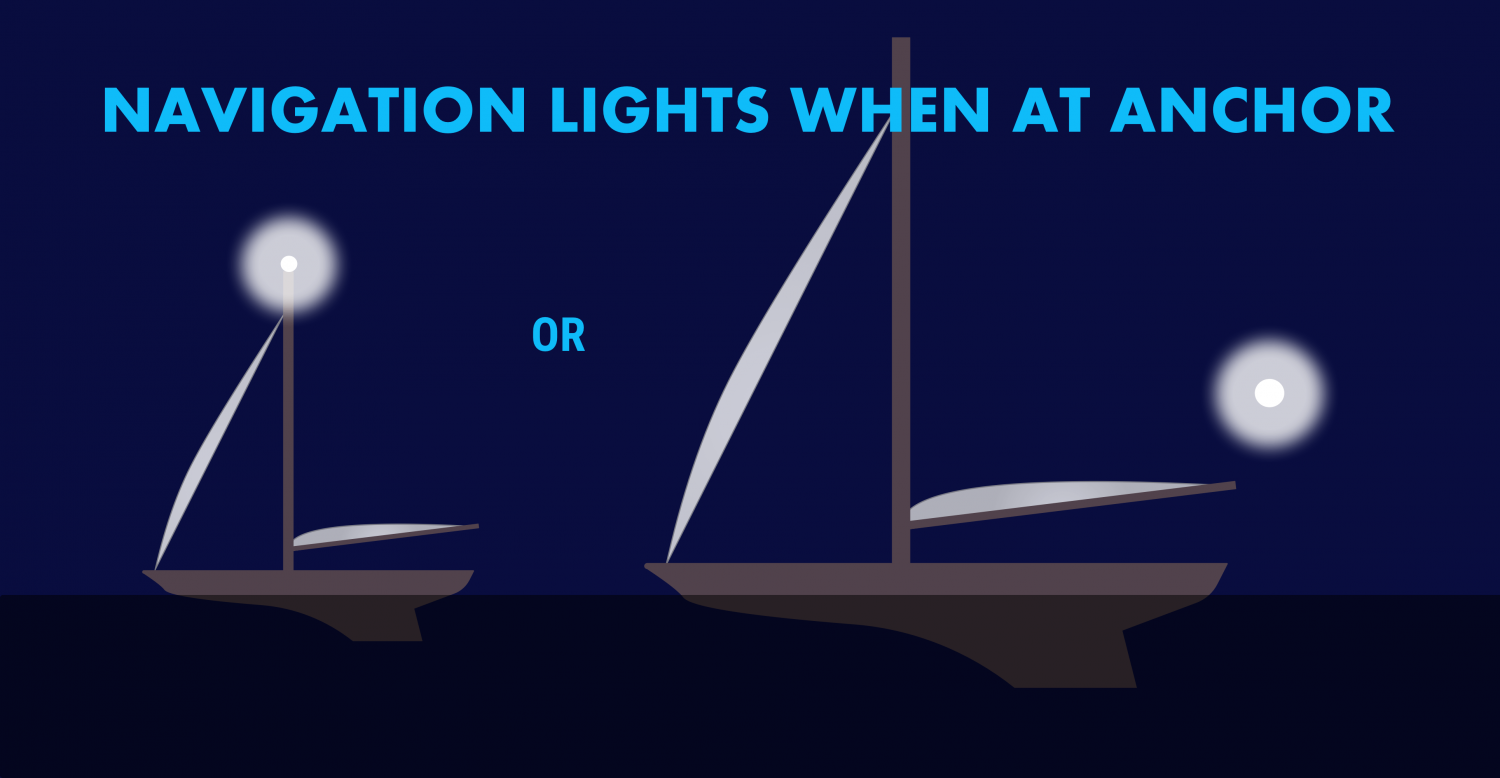
If your boat is large and has a very tall mast, you may wish to display another light closer to the waterline. Boats approaching in the dark may not see a light on a mast sixty or seventy feet in the air when they are close to your boat.
We use a simple garden path light on our stern when we anchor, left in a rod holder or flag socket. It comes on automatically at dusk and is a cheap and easy way to be more visible. There is no specific rule stating you can not display more lights than required, or the nature of any lights beyond the required all around light.
The COLREGS also specify that a round black "daymark" should be displayed in the rigging of any vessel at anchor. Very few small vessels observe this, however it is the correct display for a vessel in an anchorage.
If you tie to a mooring in a marked mooring area you are not required to display anchor lights, but there is no harm in doing so.
The other important reason to know your lights is to figure out what's going on around you at night. The water may be ablaze with white, red, green and other lights at night and they are your first key to avoiding collisions and problems.
All combinations of lights for fishing boats, commercial vessels, and so on are outside this post‘s scope. The odds are small you will encounter a submarine, seaplane or hovercraft at night, but there are regulations regarding specific lighting for each of those vessels!
There are a few fundamentals to help you figure out what that is you see on the horizon, which way it is going, and whether it is a danger to you.
Port Wine is Red
The fundamental rule is that red sidelights will ALWAYS be on the port side of a vessel, and green lights will always be on starboard. However, some vessels can use all around red and green lights for other purposes, though those will be higher than sidelights.

The light‘s on a ship is not important, some large tankers and freighters will have their sidelights far aft and put them on the superstructure for better visibility. It is not safe to assume that sidelights you can see are on the bow of large vessels .
When you can see the color, you know which way the bow is pointing. If it's red, it's pointing more or less to the left and will travel in that direction. A green light shows it is heading more or less to your right.
If you can see the red and green lights at the same time, you are looking directly at the bow of the vessel. When you are far away, this isn‘t as alarming as if you are close crossing. Seeing red and green lights together on a vessel is something you never want to see for long.
Be aware of red and green lights used in combination with other red, green and white lights. These may not be running lights and could have other significance.
Tankers, Freighters and Large Ships
Tankers, freighters and large ships will have side lights, a stern light and a masthead light. In addition, on vessels over 50 meters there will be a second masthead light further aft and higher than the forward light. The masthead light positions are a better tipoff to the bow direction and how far from the bow the sidelights might be. Remember - on a large vessel the sidelights may not be at the bow or even close to it.
USCG Inland Rules allow for a second all-around white light on large vessels on the Great Lakes instead of a second masthead light.
Fishing Boats
Fishing boats engaged in fishing will have more complex light displays. When they aren't fishing, they will show lights like any power vessel, but Rule 26 spells out light combinations that vary by the fishing activity being done. In general:
- Boats which are Trawling but not making headway will display a green all-around light over a white all-around light , and a masthead light aft of these lights. Boats making headway while trawling will show these lights, plus sidelights and a stern light.
- A vessel fishing other than trawling will show a red all-around light over a white all-around light . When making way they will also show sidelights and a stern light.
- If a vessel has gear more than 150 meters away from the boat, it will show a second all around light in the direction of the gear. The best rule is to give fishing boats as wide a berth as you can at night. They're easy to pick out if you check the top light configurations but their course may be difficult to predict.
Towing and Pushing
Towed vessels can be the most dangerous to cross, but they have the most lights to tell you what is happening. Refer to COLREGS or the USCG Rules of the Road Rule 24 for all combinations You can pick a tow/push vessel out with the following lights:
- Two or three masthead lights in a vertical line. Three masthead lights shows a tow over 200 meters. Additional masthead lights may show for larger tow vessels.
- A towing light (yellow light with the same characteristics as a stern light) directly above the stern light.
- The will also have side lights and a stern light.
- The towed vessel will show sidelights and a stern light. Lighting may vary under USCG inland rules, where towing lights may replace stern lights. Learn these differences if this is your regular cruising ground. If you think there is a tow ahead of you, always go well behind the aft most set of lights. Never go between a tow and avoid crossing ahead if possible as it may restrict their maneuverability.
Special Situations
There are several rare situations you may encounter. As a general rule, if there are a lot of lights and you don't understand them look for the sidelights on a moving vessel. If you can find them and figure out the direction it is moving, it makes the vessel easier to avoid. Stay well clear of lights you do not understand if you can avoid them without risk.
Most of these signals are used by larger, commercial vessels and you will not need them.
They use these light combinations with other light combinations. For example a towing vessel may also be restricted in maneuverability, and a vessel constrained by draft will show running lights if moving.
- Not Under Command - two all around red lights in a single line
- Restricted in Ability to Maneuver - red, white then red in a single line
- Constrained by draft - three all around red lights
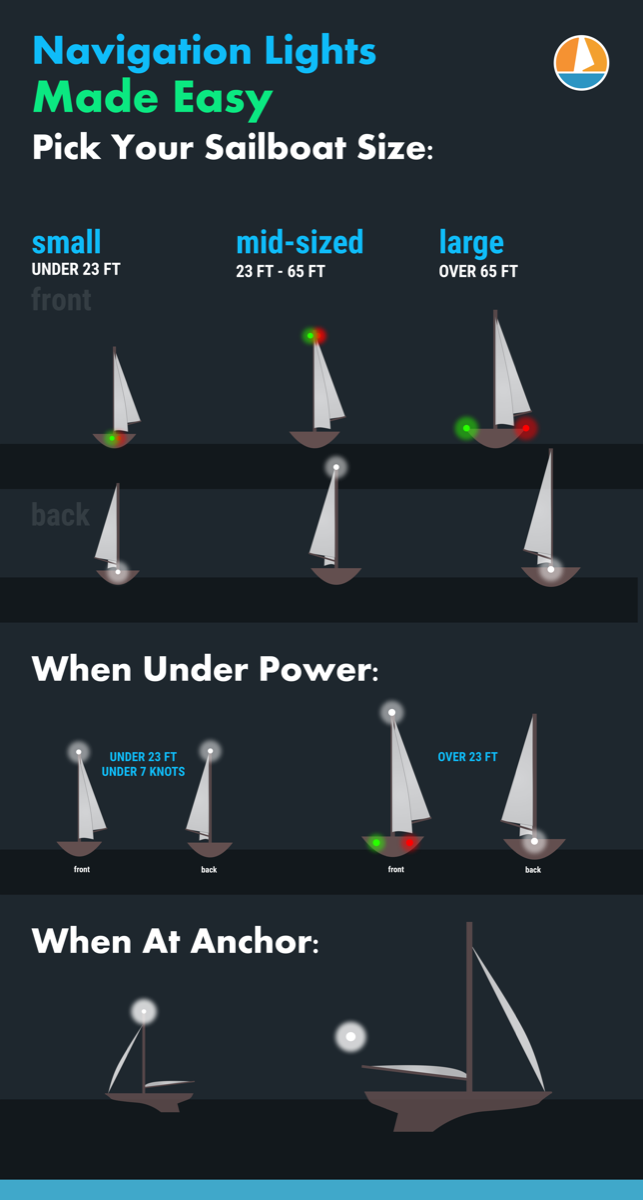
Leave a comment
You may also like, 17 sailboat types explained: how to recognize them.
Ever wondered what type of sailboat you're looking at? Identifying sailboats isn't hard, you just have to know what to look for. In this article, I'll help you.

The Ultimate Guide to Sail Types and Rigs (with Pictures)

Boat Navigation Lights: Everything You NEED to Know (2024)
In many cases, boating at night requires the use of boat navigation lights, but boaters often have many questions about them.
They often wonder when they’re needed, what the requirements are for various locations and vessels, and more.
We’re going to do a deep dive into navigation lights for boat to see what you need on your boat, and when you need to use them.
Legal Requirements
Types of navigational lights, which navigation lights are required on my boat , operators responsibility , navigation lights .
On any vessel operating on or in US waters, there is a need for the operator to display navigation lights under certain circumstances. Their purpose is to make vessels aware of each other at night or in times of generally reduced visibility. This is incredibly important during times when you may not be able to see the craft itself.
Other than visibility, marine nav lights also help boat operators determine the size, direction of travel, and even the potential activity of another boat on the water. When an operator understands the type of information each light tells them, they will be better able to determine appropriate courses of action for potential situations.
Boat running lights are divided by location and color, and each of them has specific requirements with how they must be displayed and perceived. You are the one legally responsible for displaying proper nav lights on the boat, for displaying them at the proper times, and for understanding how to read them.
The US Coast Guard ’s legal navigation light requirements include guidelines for every aspect of light usage.
Their materials start by first defining the standard daily period during which they must be used, then they detail how many of each type of light is needed as well as where they are located. Each light also has constraints regarding its visible distance and the arc over which it can be seen.
In the US, the Coast Guard says that any powered vessel that is under 39.4ft., may operate with boat nav lights in as little as two positions, an all-round light at the stern, and a set of sidelights at the bow.
Vessels that are under 164ft. must have lights displayed in four positions, a stern light, a masthead light, and boat sidelights on both the port and starboard, near the bow.
The ship navigation lights also have minimum visibility distances, depending on the size of the craft. The minimum visibility for nav lights, even for small crafts, is one mile, with requirements that other lights on larger vessels be visible for up to 3 nautical miles.
Also read: Boating Rules and Etiquette On the Water
Boat lights come in 4 types, sidelights, stern light, masthead light, and all-round light. Lights only come in white, red, and green, and all have very specific jobs.
| White | Over fore and aft centerline of the boat | 2 miles | 5 miles | 225 degrees | |
| Red | On the port side, 22.5 degrees abaft the beam | 1 mile | 2 miles | 112.5 degrees | |
| Green | On the starboard side, 22.5 degrees abaft the beam | 1 mile | 2 miles | 112.5 degrees | |
| White | Near as possible to the stern | 2 miles | 2 miles | 135 degrees | |
| White, Yellow, Tricolor | N/A | 2 miles | 2 miles | 360 degrees | |
| Green, Red, White | Over fore and aft centerline of the boat | N/A | N/A | 360 degrees | |
| Two White Vertical, Three White Vertical | Over fore and aft centerline of the boat | 2 miles | 2 miles | 135 degrees | |
| Flashing Blue | Anywhere not interfering with other lights | 2 miles | N/A | 180-225 degrees |
Masthead Light
The masthead light is the white light located about ⅔ of the way up the mast, rather than at the top as you’d think. This boat bow light is required when using motor power at night. To be acceptable, the light must have an arc of 225° and needs to be seen from 2 miles away.
Large boats can have up to 3 mast lights. If your boat is shorter than 39 ft., all 2-3 white mast lights can be combined, utilizing one larger white light at the top of the mast.
Color : White ARC : 225 degrees Position : Front of boat
Port Sidelight
The boating lights located on the port side of the watercraft are red and mounted so that boats can see as they approach either head-on or from the left. This light helps tell if a boat is coming towards you or if it is pointing away. The phrase “red, right, returning” means that if you see a boat with their red navigation light on the right, they are facing your boat. The only time it is not needed is when your boat is anchored for the night .
Color : Red ARC : 122.5 degrees Position : Forward, left side
Starboard Sidelight
If you are to approach a boat from the front or right, you will see the green starboard sidelight. With an ARC of 122.5 degrees, approaching boats will be able to see yours easily.
This light helps tell you whether or not you have the right of way, which is important when it comes to keeping both you and your passengers safe. These are some of the front boat lights.
This light will often be combined with the port light, in small boat navigation lights. When out in the water, if you see the green light, that means it is safe for you to go, as you have the right of way.
Color : Green ARC : 122.5 degrees Position : Forward, right side.
The rear boat light is called the stern light. It is used to mark the rear of the boat. The operator can infer from only setting a boat stern light, that they are directly behind the vessel.
The stern light is white and is visible for an arc of 112.5 degrees on both the port and starboard sides, making a full arc of 225. Being able to see the red starboard side light as well as the stern light, should indicate the other vessel is traveling to the right from the perspective of the observer.
Color : White ARC : 225 degrees Position : Stern
All-Around Light
One of the boat night lights that is required when on your boat between sunset and sunrise is the all-around light. This light is intended to be seen from any point and helps to tell what direction a boat is moving. This light is also used when a boat is stopped or anchored.
This anchor light is required to have an ARC of 360 degrees and should be visible for two miles. The all-around light is white and it is located at the top of your boat’s mast for maximum visibility.
Color : White ARC : 360 degrees Position : Top of mast
Tricolor Light
A tricolor light is a sailboat mast light that has your three types of bow light in one convenient piece of equipment. They are for sailboats that are smaller than 65.6 feet long. The point of this sailboat light is to increase your nighttime visibility. They are mounted at the top of the mast, allowing larger boats to see yours better. They are not permitted to be used by any boats with a motor. The only type of boat that can utilize a tricolor light is a sailboat.
Color : White, red, green ARC : 360 degrees Position : Top of mast
Towing Light
These yellow lights are important, as they indicate to other watercraft that, not only is there another boat nearby but that they are also towing someone as well. The light must be positioned at the back of the boat, as close to the stern as possible. The goal is to avoid having anyone run into the boat that is being towed, as there may be no lights showing where that boat is located. The boat lighting requirements when towing state that both sidelights, a stern light, and masthead lights should also be displayed.
Color : Yellow ARC : 135 degrees Position : Over fore and aft centerline of the boat
Law Enforcement Light
Lights used by law enforcement on the water are flashing blue lights that can flash 120 times per minute or more. They can be used nearly anywhere that is convenient for the operator, provided they do not interfere with the function of the other lights.
This light may be displayed by any type of local law enforcement that is engaged in the course of their duty. This can apply to local, state, or federal police, as well as officials from wildlife and conservation departments, the Coast Guard, and more.
Color : Flashing Blue ARC : 180-225 degrees Position : Anywhere not interfering with other lights
Find your boat type below for the lineup of nav lights that you will need to safely operate after sunset and in other times of limited visibility.
Be sure you know which lights you will need to have on while underway, as well as at anchor or while towing. If you’re sailing, don’t forget that you are considered power-driven when using your motor.
Powerboat under 23 feet (7m)
Powerboats under 23 feet are required to have the following navigation lights displayed:
- One white masthead light visible for 2 miles
- One red & green sidelight visible for 1 mile
- One stern light visible for 2 miles
- One white, red, green, or yellow all-round light visible for 2 miles
Powerboat Under 39,4 feet (12m)
Powerboats under 39,4 feet are required to follow these boat light rules:
- One all-round light visible for 2 miles
Powerboat Over 39,4 feet (12m)
Powerboats over 39,4 feet are required to have the following navigation lights displayed:
- One white masthead light visible for 5 miles, unless less than 20 meters, then 3 miles
- One red & green sidelight visible for 2 miles
Powerboat 39,4 feet (12m) to 164 feet (50m)
Powerboats between 39,4 feet and 164 feet are required to have the following marine running lights displayed:
- One white masthead light visible for 6 miles
- One red & green sidelight visible for 3 miles
- One stern light visible for 3 miles
- One all-round light visible for 3 miles
Sailboat Under 23 feet (7m)
Sailboats under 23 feet are required to have the following sailing navigation lights displayed:
- One white stern light
- One white mast lantern positioned at or near the top of the mast where it can be easily seen from a distance
Note: if it is not practicable for the vessel to display the prescribed lights, one all-round white light can be used or a hand torch, with enough time to prevent a collision.
Sailboat Under 65,6 feet (20m)
Sailboats under 65,6 feet are required to have the following sailing lights displayed:
Tug Boat With Tow Length Under 656 feet (200m)
Tug boats with tow lengths less than 656 feet are required to have the following navigation lights displayed:
- Two masthead lights in a vertical line
- Stern light
- Towing light in a vertical line above the stern light
Tug Boat With Tow Length Over 656 feet (200m)
Tug boats with tow lengths longer than 656 feet are required to have the following navigation lights displayed:
- Three masthead lights in a vertical line
- A towing light placed vertically above the stern light
- A diamond shape visibly displayed
Anchored Vessel
Vessels at anchor or aground are required to observe the following boat lighting rules:
- One white all-round in the fore
- One white all-round at a lower level than the fore, at the stern
If aground, the vessel should display two red all-round lights in a vertical line
Vessel Under Oars
Vessels under oar power have similar requirements to follow as small sailboat lighting:
- One stern light
Or, alternately, one white all-round light or hand torch to be used to manually signal to avoid collision
Vessel Engaged in Fishing
Vessels actively engaged in fishing are required to have the following marine navigation lights displayed:
- Two all-round lights oriented in a vertical line, red on top and white on the bottom
- One all-round white light for gear more than 150 meters from the vessel
- When making its way through the water, there shall also be sidelights and stern light
Vessel Engaged in Trawling
Vessels engaged in trawling are required to fulfill the following boat light requirements:
- Two all-round lights oriented in a vertical line, green on top and white on the bottom
- One masthead light abaft and higher than the all-round green
Kayakers and Canoers
Kayakers and canoers are required to have the following navigation lights displayed:
Alternatively, a hand torch or lantern which can be used to signal to avoid collisions
Personal Watercraft
There are no established rules for navigation lights on personal watercraft, even though many of them are classified as a boat by coast guard standards. Personal watercraft are often not permitted to operate outside of the sunrise-to-sunset period, and so most manufacturers do not install or make possible the installation of navigation lights.
Vessels Restricted in their Ability to Maneuver
Vessels restricted in their ability to maneuver are required to have the following navigation lights displayed:
- Three all-round lights displayed as high a possible in a vertical line, red at the top, and white in the middle
- One masthead light
The USCG as well as state authorities hold the operator of the vessel responsible for the correct use and understanding of nav lights.
This means they also must make sure all of the lights used meet the requirements set forth by the authorities.
This also extends to ensuring that the lights are all installed for optimal visibility while underway, so if your cruiser rides high, make sure your lights are still visible.
What navigation lights do I need on my boat?
Boat light regulations state boats must have a pair of red and green sidelights, and an all-around white light that can be seen from 360°.
Why are navigation lights red and green?
Navigation lights for boats indicate to others which direction a boat is facing. The red indicates the left side of the boat, green is on the right.
What lights need to be on a boat at night?
Per the navigation lighting rules, it is crucial that you have your red and green navigation lights, as well as the white 360° light.
Which three colors are used for navigational lights?
The boat light colors are going to be green, red, and white. If you see a blue light, this generally indicates a government vessel.
Do I need navigational lights on my boat?
Yes, all boats are legally required to have the minimum red, green, and white boat safety lights
when operating in the dark.
Why do boats have blue lights?
When you see a boat that has blue boat lights at night, that means that it is likely the coast guard or law enforcement.
Why is port red and starboard green?
The light on the starboard side of the boat is green because it is ‘safe’, as the steersman will be able to see other boats.
What does a single white light mean on a boat at night?
If you can only see a single white light on a boat at nighttime, you are likely seeing the stern light or the boat anchor light.

Robert Owens is the Chief of Content of Quicknav. Robert has been boating for over ten years and loves to share his experience on the water. His first boat was a dirt-cheap moderately beat up 2003 Bayliner 175, where he learned a tremendous amount about trailering, launching, docking, operating, and maintaining. He currently owns a Cruiser Yacht and is eyeing a sailboat.
Similar Posts

How to Get a Marine Radio Operator Permit in 2024?
Obtaining your marine radio operator permit from the FCC is only a necessity under certain circumstances (1), but they allow…
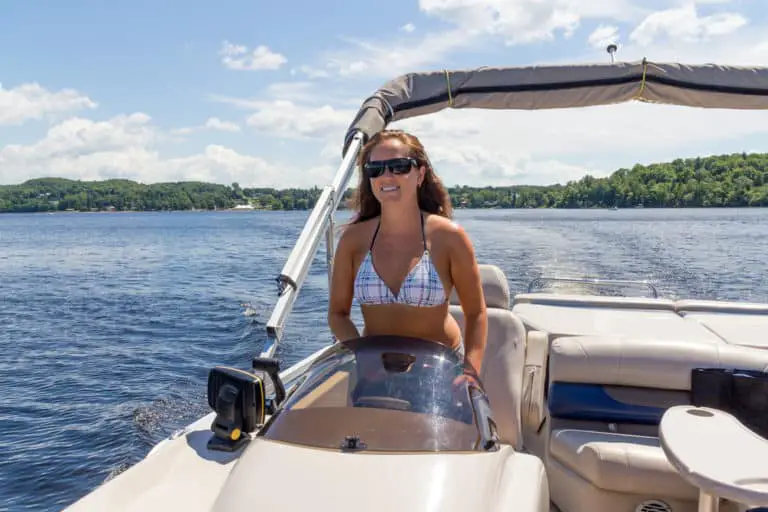
How to Drive a Boat? (Step-by-Step Guide)
Now that you have a boat, or are close to picking up that new toy, one major hurdle you will…
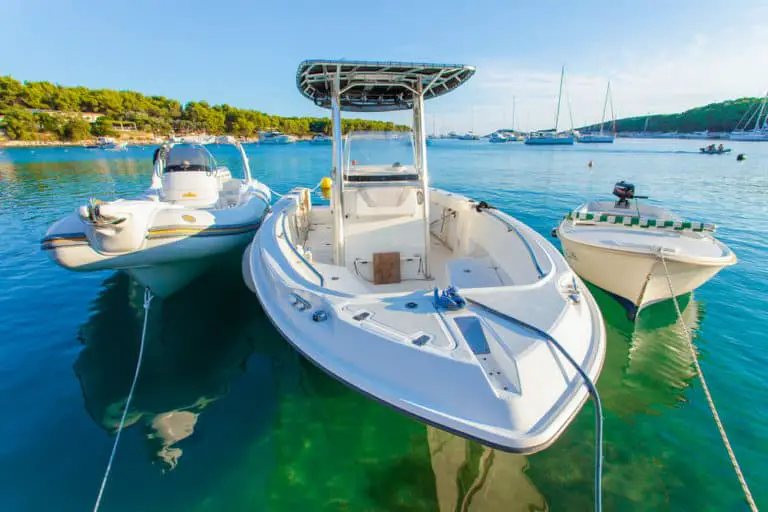
Types of Boats: The Ultimate Guide (2024)
When taking into consideration the different types of boats that navigate the fresh and saltwater bodies of the Earth, the…
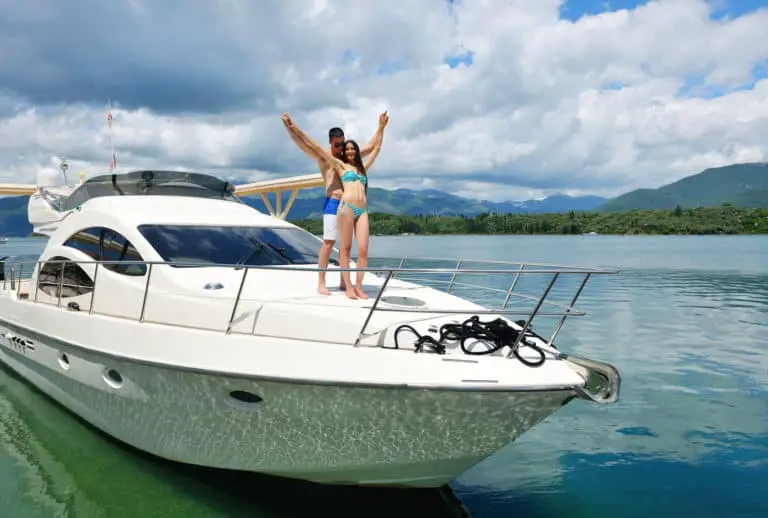
How Much Does a Boat Cost in 2024? (With Ownership Costs)
Residents all across the US are buying more boats than ever before. From kayaks and canoes to the most luxurious…
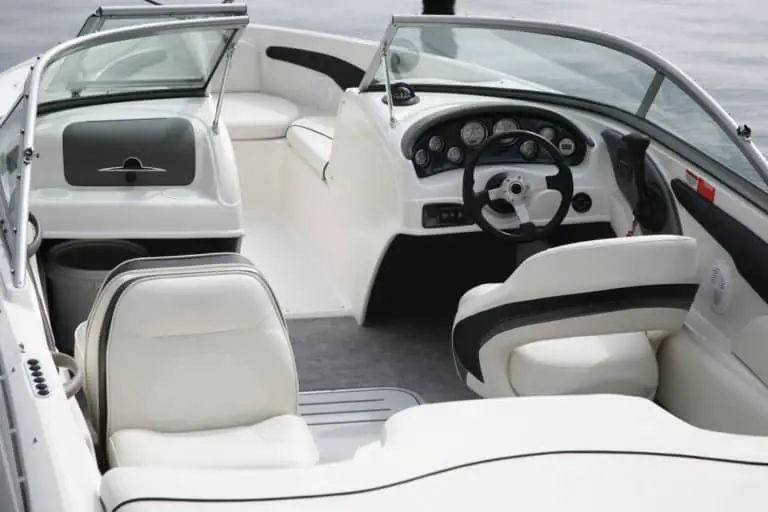
How to Clean Boat Seats? (a Practical Guide)
So you’ve bought your first boat and while you think you can master most of it with ease, you keep…
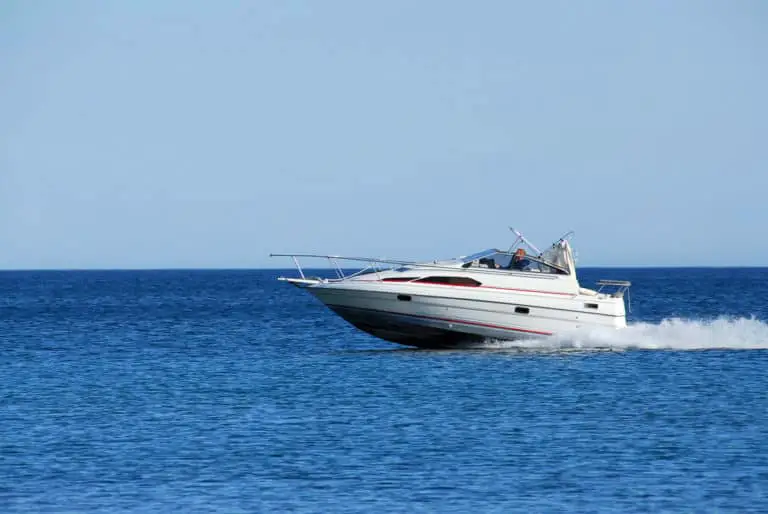
Boating Rules and Etiquette On the Water (2024)
Understanding the basic boating rules that are needed for the safe operation of a vessel, whether inland or out at…

What is a Properly Lit Sailboat at Night? (A Guide to Safety Regulations)

Have you ever been out on the open water and seen a sailboat with its lights on at night? It’s a beautiful sight to behold.
But did you know that there are specific safety regulations in place for properly lit sailboats? In this guide, we’ll be looking at the importance of having a properly lit sailboat, what types of lights are needed, how to install them, and how to test for proper operation.
Let’s get started and learn how to stay safe on the waters!
Table of Contents
Short Answer
A properly lit sailboat at night is a boat that is equipped with the correct navigation lights, which are required by law.
These lights must be visible for two miles and should include a green light on the starboard side, a red light on the port side, and a white light aft.
Additionally, the boat must also have a white masthead light that is visible for three miles.
The masthead light should be mounted at least two meters above the hull.
What Are the Safety Regulations for Properly Lit Sailboats?
When it comes to sailing at night, safety is of the utmost importance.
Properly lit sailboats ensure that they are visible to other boats, which reduces the risk of collisions and other accidents.
In order to ensure that a sailboat is properly lit at night , there are certain safety regulations that must be followed.
First and foremost, the sailboat must have the correct lighting equipment installed and in good working order.
This includes running lights (red and green lights found at the bow and stern of the vessel), an anchor light (a white light mounted on the masthead or the bow of the vessel), a stern light (a white light placed at the stern of the vessel), and a masthead light (a white light placed at the highest point on the vessel).
The running lights, anchor light, and stern light must be visible for at least 3 miles in clear conditions.
This allows other boats on the water to easily spot the sailboat, even in the dark.
The masthead light must be visible for at least 2 miles in clear conditions.
This ensures that the sailboat is easily seen from all directions.
In addition to having the correct lighting equipment, sailboats must also be equipped with a white all-round light.
This light must be visible for at least 2 miles in clear conditions and must be mounted on the mast at least 9 meters (or 30 feet) above the waterline.
The all-round light is an important part of a sailboats lighting system as it allows other boats to easily spot the sailboat from any direction.
These are just a few of the safety regulations that must be followed when it comes to properly lit sailboats.
Following these regulations will help to ensure that a sailboat is visible to other vessels on the water and will help to reduce the risk of accidents and collisions.
It is important that all sailors understand and adhere to these regulations in order to remain safe on the water.
Types of Lights Needed for Proper Lighting

When it comes to lighting a sailboat at night, there are a few key components that must be in place in order to ensure the safety of the vessel and the crew.
The most important of these components is the correct type of lighting equipment.
This includes various running lights, anchor lights, masthead lights, and stern lights.
Running lights are the red and green lights that are mounted on the bow and stern of the vessel, and are used to show the direction of travel of the boat.
They must be visible for 3 miles in clear conditions, making it easier to spot the boat in the dark.
Anchor lights are white lights that are mounted on the masthead or the bow of the vessel, and are used to show that the boat is anchored.
They must also be visible for 3 miles in clear conditions.
The stern light is a white light placed at the stern of the vessel.
This is used to show the direction of travel of the boat and should also be visible for 3 miles in clear conditions.
Finally, the masthead light is a white light placed at the highest point on the vessel.
This light is used to help identify the boat to other vessels on the water, and must also be visible for 3 miles in clear conditions.
Having all of these lights in good working order is essential for the safety of the boat and the crew.
It is important to make sure that all lights are visible from a distance of 3 miles in clear conditions, as this will make it easier to identify the boat in the dark.
It is also important to make sure that all lights are regularly inspected and maintained in order to ensure that they are in good working order.
How to Install the Lights
Installing the lights for a properly lit sailboat at night is an essential part of staying safe while sailing.
It is important to ensure that all of the lights are in good working order and that they meet the safety regulations for visibility.
The first step is to select the right lights for your vessel.
There are two main types of lights running lights and anchor lights.
Running lights are the green and red lights found at the bow and stern of the vessel, while anchor lights are white lights mounted on the masthead or bow of the vessel.
Once the lights are selected, the next step is to install them.
Start by attaching the anchor light to the masthead or bow of the vessel.
The anchor light should be securely mounted and wired in accordance with the manufacturers instructions.
Next, attach the stern light at the stern of the vessel.
This should also be securely mounted and wired in accordance with the manufacturers instructions.
Finally, attach the running lights.
These should be mounted at the bow and stern of the vessel.
It is important to test the lights after installation to make sure they are working properly.
Make sure that the lights meet the visibility requirements of 3 miles in clear conditions, as this is the minimum distance that the lights must be visible from.
Once the lights are installed and tested, youre ready to set sail in the dark!
Importance of Properly Lit Sailboats

When it comes to sailing, safety is of the utmost importance.
This is why it is essential for all sailboats to be properly lit at night.
Having the correct lighting equipment installed and in good working order is a critical component to ensure visibility and the safety of everyone on the water.
Not only does having properly lit sailboats maintain the safety of the sailors on the boat, but it also helps to prevent collisions with other vessels.
It is much easier to spot a sailboat on the water at night when it has the correct lighting equipment, such as running lights, anchor lights, stern lights and masthead lights.
All of these lights should be visible for at least 3 miles in clear conditions, making it much easier to spot a sailboat on the water.
Additionally, having properly lit sailboats at night is also important for law enforcement and marine patrol officers.
It makes it easier for them to identify and inspect boats, ensuring that all safety regulations are being followed.
This helps to keep the waterways safe for all boaters.
For these reasons, it is important for all sailboats to be properly lit at night.
By having the right lighting equipment installed and in good working order, it can help to maintain the safety of everyone on the water, as well as help to prevent collisions with other vessels.
It also makes it easier for law enforcement and marine patrol officers to identify and inspect boats, helping to keep the waterways safe for all boaters.
Different Types of Lights and Their Functions
When it comes to lighting a sailboat at night, there are several different types of lights that must be installed and in good working order in order to ensure the safety of the vessel and its occupants.
The most common types of lights used on sailboats are running lights, anchor lights, stern lights, and masthead lights.
Running lights are the green and red lights found at the bow and stern of the vessel.
These lights are typically used to signal the direction of the boats movement, and must be visible for 3 miles in clear conditions.
The green light is typically placed on the port side (left side) of the boat, and the red light is placed on the starboard side (right side).
Anchor lights are white lights mounted on the masthead or bow of the vessel.
They are used to indicate that the boat is at anchor, and must also be visible for 3 miles in clear conditions.
Stern lights are white lights placed at the stern of the vessel.
These lights indicate the boats direction of travel, and must be visible for 2 miles in clear conditions.
The masthead light is a white light placed at the highest point on the vessel.
This light is typically used in conjunction with the stern light to indicate the direction of travel, and must be visible for 2 miles in clear conditions.
In addition to these lights, boats may also be fitted with a variety of other lights such as tricolor lights, sidelights, all-round lights, and deck lights.
These lights are typically used to indicate the presence of the vessel in low-visibility conditions, and must be visible for 2 miles in clear conditions.
It is important to ensure that all lights on a sailboat are in good working order and visible from a distance in order to make the vessel visible to other boats and comply with safety regulations.
A properly lit sailboat at night is one that has the correct lighting equipment installed and in good working order.
Benefits of Properly Lit Sailboats

Having a properly lit sailboat at night is essential for staying safe on the water.
With the right lighting equipment installed and in good working order, you can be easily seen by other vessels and prevent possible collisions.
Additionally, having the right lights on your sailboat can help other boaters determine your vessels size, direction, speed, and even your intentions on the water.
Having the right lights can also give you a sense of security while youre out at night.
Knowing that youre visible to other vessels reassures you that youll be able to be seen and spotted if you need assistance or if theres an emergency.
When youre out on the water at night, having a properly lit sailboat can also make navigation easier.
By having the correct lighting equipment installed, youll be able to easily spot buoys, markers, and other vessels, making it easier for you to stay on course and reach your destination in a timely manner.
Having the proper lights also helps to keep your sailboat in compliance with safety regulations.
If youre stopped by the coast guard or other law enforcement, having the right lights can help to avoid any potential fines or penalties.
Overall, having a properly lit sailboat at night is essential for staying safe on the water.
Not only does it make it easier for other vessels to spot you, but it can also help with navigation and make sure that youre in compliance with safety regulations.
Properly lit sailboats can also give you a sense of security and peace of mind, knowing that youre visible to other vessels in the area.
How to Test Lights for Proper Operation
Testing lights on a sailboat at night is an important part of ensuring that the craft is properly lit and visible to other vessels.
It is essential for safety, as well as compliance with regulations set by the United States Coast Guard.
Before each voyage, it is important to inspect all of the lights and make sure that they are in proper working order.
The first step to testing lights is to turn them on and check that they are functioning correctly.
It is important to make sure that all of the required lights are present and that they are bright enough to be seen in clear conditions for up to 3 miles away.
The running lights should be a green light at the bow and a red light at the stern, while the anchor light should be a white light mounted on the masthead or the bow of the vessel.
The stern light should be a white light placed at the stern, and the masthead light should be a white light placed at the highest point on the vessel.
Another important step in testing lights is to make sure that they are not obstructed in any way.
This includes checking for any wires, cables, or other objects that could block the lights from being visible.
This is especially important for the masthead light, as it needs to be accessible in order to be seen from a distance.
It is also important to check the wiring of the lights to make sure that they are securely connected and not corroded or damaged.
Finally, it is important to check the bulbs of the lights to make sure that they are all functioning correctly.
It is important to check the wattage of the bulbs to make sure that they are bright enough to meet the standards set by the United States Coast Guard.
It is also important to make sure that the bulbs are not cracked or damaged in any way, as this could affect their visibility.
Following the steps outlined above will help to ensure that all of the lights are in proper working order and can be seen from a distance in clear conditions.
This is important for safety, as well as compliance with regulations set by the United States Coast Guard.
Final Thoughts
Having the correct lights installed and in proper working order on your sailboat is essential for safety and visibility on the water at night.
Knowing what type of lights you need, how to install them, and how to test them for proper operation is key.
While it may seem daunting to install and maintain all these lights, the benefits of having a properly lit sailboat at night far outweigh the effort.
So take the time to review safety regulations, and make sure you have the right lights installed and operating correctly to ensure a safe and enjoyable sailing experience.
James Frami
At the age of 15, he and four other friends from his neighborhood constructed their first boat. He has been sailing for almost 30 years and has a wealth of knowledge that he wants to share with others.
Recent Posts
When Was Banana Boat Song Released? (HISTORICAL INSIGHTS)
The "Banana Boat Song" was released in 1956 by Harry Belafonte. This calypso-style song, also known as "Day-O," became a huge hit and remains popular to this day for its catchy tune and upbeat...
How to Make Banana Boat Smoothie King? (DELICIOUS RECIPE REVEALED)
To make a Banana Boat Smoothie King smoothie at home, start by gathering the ingredients: a ripe banana, peanut butter, chocolate protein powder, almond milk, and ice. Blend the banana, a scoop of...
Get your card today

- Pre-paid code

- Buy a Gift Card
Boat Navigation Light Rules and Requirements

Boat navigation lights are one of the most important pieces of safety equipment on your boat, along with personal flotation devices , boat fire extinguishers and boat ventilation systems .
As a boat owner or operator, you are legally responsible for using the correct safety equipment at all times. This is your responsibility whether your boat is moving through the water or you are at anchor, day and night, in all types of weather.
Did you know that boat manufacturers, importers and dealers are not responsible for equipping your boat with legally acceptable navigation lights ? Before you take to the water, check that your navigation lights are:
- the right size and type for your boat and chosen water activity
- the right color and intensity
- attached to the correct parts of your boat
- fully operational.
It’s important to learn all you can about navigation lights for safe, legal boating! Keep reading to find out which lights to use when.
What are navigation lights for?
Navigation lights allow you to see and identify other vessels, and allow other boats to see and identify you. There is not one simple way to use navigation lights; the way they are set up on your boat will indicate the size, activity, and direction of travel of your vessel, so that you and other boat operators can make good decisions and avoid collisions.
By understanding what navigation lights mean, you will be able to safely and legally navigate shared waters under a variety of circumstances.
Boat navigation light requirements
Paddleboats, rowboats and small sailboats generally do not need to display navigation lights, but most other boats are legally required to use some or all of the following:
- A green light to indicate the starboard (starboard sidelight) attached near the bow on the starboard side
- A red light to indicate the port (port sidelight) attached near the bow on the port side
- One or more white lights (stern light and masthead light)
- Other navigation lights , such as blue flashing lights for law enforcement vessels engaged in search-and-rescue (SAR) operations, or yellow lights for vessels that are towing or being towed
Each type of navigation light also has a defined arc of illumination and range of visibility. Angles of visibility must be met when the boat is underway, which means that if your boat rides at a significant bow-up angle, you may need to adjust your navigation lights to compensate.
You must always use navigation lights between sunset and sunrise or in reduced visibility, but there are some exceptions during clear, daytime boating.
Note: It is also important to keep a flashlight on board as a temporary replacement, in case a navigation light burns out.
Boat navigation lights while underway
While your boat is underway, you are legally responsible for displaying the right type of navigation lights. Choosing the right lights depends on several factors, including:
- Whether your boat is powered by an engine (in full or in part)
- The size of your boat , measured in length
- Your boat’s speed
- Where you are boating (inland, international water, etc.)
- Whether you are at anchor.
Remember that your navigation lights must be visible and easily identifiable as such. Other lights on your boat cannot be mistaken for navigation lights, or get in the way of your navigation lights
Sailboat navigation lights
If you are operating a sailboat or nonpowered boat such as a canoe, kayak or rowboat, you still need to use the correct configuration of navigation lights for your boat size and boating circumstances. For comprehensive detailed instructions on navigation lights please refer to the USCG resource. The following are general guidelines:
Sailboats or vessels using paddles or oars, under 23 feet in length:
- One white navigation light (or lantern or flashlight) that is visible from 2 nautical miles away between sunset and sunrise or during periods of low visibility. In the presence of another vessel, the light must be displayed in time to avoid a collision.
Sailboats between 23 and 65.6 feet:
- One white stern light visible at 135 degrees and from 2 nautical miles
- One green starboard and one red port sidelight, visible across 112.5 degrees from one nautical mile away
- A tricolour light, which is a single all-around light which includes the three coloured of lights indicated above, facing the same directions, visible from a distance of 2 nautical miles. This type of light can only be used when under sail, and never when using a motor regardless of whether the sails are hoisted. It may not be used at the same time as regular sidelights.
Powered boat navigation lights
If you are operating a boat with an engine (including sailboats with motors), between sunset and sunrise or under conditions of restricted visibility, you need navigation lights.
Powered boats under 39.4 feet:
- One all-around white light, visible from all directions (360 degrees) from two nautical miles away. This light must be attached at least 39 inches above the sidelights.
Recreational powered boats between 40 feet and 164 feet:
This size of boat requires two white lights which, combined, make up 360 degrees of visibility:
- A white masthead light at the bow, visible across 225 degrees, from 2 nautical miles away. This light must be attached at least 8 feet above the gunnel.
- A white stern light at the stern, visible across 135 degrees and from 2 nautical miles away.
In addition to:
- One green starboard and one red port sidelight, visible across 112.5 degrees from one nautical mile away.
Boat navigation lights at anchor
When your boat is anchored at a dock, it is not necessary to turn on your navigation lights. However, if you are at anchor in an undesignated area, you need to make other boats aware that you are not moving by displaying an all-around white light where it will be easily visible to any other boats in the area.
Diving lights
If you are boating in a resort area or anywhere there are sunken wrecks or coral reefs, keep in mind that there could be diving activity. Keep your distance and stay alert to the possible presence of divers underwater.
Boats that are accompanying divers must display:
- Three vertical masthead lights in a red-white sequence.
Interpreting boat navigation lights
Installing and using the right navigation lights on your boat is very important, but to navigate safely, you also need to be able to interpret the navigation lights on other boats.
Remember, you may not always be boating under ideal circumstances. Make sure you learn to understand navigation lights and the United States Coast Guard rules of navigation , also called the Rules of the Road , thoroughly, so that you can make good decisions quickly, as needed.
Do you see a green light over a white light? This indicates a fishing vessel that is actively trawling. It may be necessary to avoid not only the boat, but also a large net.
Do you see a red light to the left, with two white lights to the right? Understand that you must yield to the other boat.
There are many other configurations you need to be familiar with to operate your boat safely.
Avoiding collisions
Remember, navigation lights are only a tool. You must also maintain a proper look-out at all times, by sight and hearing, to responsibly avoid collisions. Skippers must drive at an appropriate speed so that you can take effective action to avoid colliding with another vessel or body under or on the water.
Factors like visibility, traffic density, the maneuverability of your vessel, the presence of other lights from shore or scattered boat lights, the state of the sea and the draft in relation to the available depth of water must always be taken into consideration. Radar equipment may also pose certain limitations or offer certain benefits to navigating safely.
It is the boat operator’s responsibility to do everything in their power to avoid a collision, including but not limited to the correct display of navigation lights.
Learn about boat navigation and more from Drive A Boat USA!
Driving a boat safely demands a thorough knowledge of navigation, safety procedures and other technical details.
What you need to know depends in part on where you intend to go boating, the size and type of boat you will use, and what type of activity you will be engaged in, but there are many basic rules and regulations that you are legally obliged to follow no matter what the circumstances.
You can get your official state-approved online boating license today! Sign up for our fun and engaging boating safety course to get started.
- USA Boating
Latest Posts
- Everything You Need to Know About Safe Boating with Dogs
- All About Vessel Safety Checks (VSC) in the U.S.
- Common Causes of Boat Fires
- Tips and Tricks for Docking Your Boat
- Diver Down Flag: What It Looks Like and When To Use It
- August 2024
- February 2024
- December 2023
- October 2023
- September 2023
- January 2023
- November 2022
- Get certified now
- Replacement California Boater Card

Navigation Lights for Sailboats (And How To Read Them)

Last Updated by
Capt Chris German
June 15, 2022
Navigation lights on a sailboat can be confusing. If you understand the reason behind why they are the way they are however, they can make a lot more sense.
At their heart, sailboats are really just a power boat and as such must adhere to all power boat rules such as navigation lights. Other times however, a sailboat is classified in a special category. They have a set of additional lights they CAN show as an option, but are not always required to do so.
That’s about as clear as mud if you ask me and I contend that that is where the confusion about lighting a sailboat begins.
Just because you can show a light to identify yourself in times of low visibility, does not mean you have to and then we add in a little sibling rivalry between power and sail and things get downright adversarial when it comes to navigation and the night.
Table of contents
The USCG says You’re a Power Boat Whether You Like It or Not
Much to the consternation of many a sailor who has earned a commercial license to drive their sailboat, when you received your credential from the USCG it says you are a master of steam and power across the top with no mention of wind as a source of propulsion.
It is not until you read the back pages of your little red book that feels like a passport and looks like a US Sailing credential, that you will see the term “sail auxiliary”. That is because most of the time the U.S. Coast Guard knows that you are primarily reliant on your mechanical power to propel your vessel.
It's a sad thing, but the days of commercially viable sail boats are done and all but the most select few even have sails let alone use them as their primary power source. All sail boats by law are powerboats, but not all powerboats are sailboats.
Navigation Lights for a Power Boat
As a power boat, you are required to show certain lights and have been required to do so before power was even invented.
In the days of man powered vessels like the viking ships who relied on oars while in close quarters to power their vessels, they needed to show other boats, friend or foe, where they were by showing lanterns in the dark to identify themselves. As you know, it is a time honored rule among all the nations of the world both past and present, that you must avoid a collision at all costs while at sea and even the viking knew that you should not run into things.
By lighting the front and back of your boat, you could warn other boats of your presence as well as identify which way you were heading. As such there is a very specific rule in the Code of Federal Regulations Number 46 (CFR46 by common name) that spells out with detail how many, the color, the luminosity or brightness, the angle of visibility and the location of all of the lights required for navigation on every single boat, seaplane, submarine and other nondescript vessel conceived by man to date that they must show while underway in reduced visibility.
And there is no flexibility in the rules.
As such a power boat, and by extension all sailboats, MUST, without question show one green light on the starboard bow and one red light on the port bow and one all around white light or lights while operating in reduced visibility. These lights should shine at all 360 degrees of visibility with the bow lights shining at an angle of dead ahead to 22.5 degrees abaft the beam and the stern lights shining 225 degrees dead aft. A forward facing masthead light that is white in color shall shine forward to comply with the directive that all vessels must carry an all around white light. For more read here .
As you can see, there isn’t much wiggle room when it comes to lights that must be shown.
Sailboats get a little flexibility with lights
Sailboats however, are a little different when they are in fact sailboats, which is only when you are entirely reliant on the wind for power and in no way reliant on any mechanical or manual means of propulsion. And for good reason.
Back in the day when men were men and sailboats were wooden, fire was a major concern. Sails were coated with wax and other flammable substances and the wood on boats was saturated with oils and grease. Even the ropes were plant materials saturated with oils to keep them pliable and strong.
Add those highly flammable substances to a parching environment like the sea and you had what was essentially a giant floating tinderbox.
Then tell that giant floating tinderbox that they need to identify themselves to the world at large at night using oil lamps with flames because batteries and lights were not invented yet. It didn't take very long or very many ships burning to the water line for the Governments to say to the sailboats, you get to do things a little different.
As such, sailboats are given special dispensation when it comes to lights aloft. They don't have to show an all around white light in their rigging because no one wanted to set their rig on fire with oil lamps 60 feet up in their rig.
However, when a sailboat takes their sails down such as when they are powered or at anchor, they must resume the display of an all around white light or lights aloft. That became a real challenge with aluminum masts and the disappearance of rat lines on the shrouds because there was no easy way to climb the rig and check the bulbs up the mast on a regular basis.
Red over Green Sailing Machine
I have no idea where the history of this particular light comes from, but if you ever take a deck exam with the USCG, you better remember this mnemonic. An all around red light over an all around green may be displayed on a vessel during times of reduced visibility to indicate that a vessel is operating under sail power alone.
I won’t even speculate on how or why they came up with this particular light configuration, but if you want to use these lights as a sailing vessel, you can do so, but that means that you will need three all round lights at the top of your mast, an all around white, an all around red and an all around green, just in that order.
The red over green is to be displayed in addition to the running lights or the red and green bow lights with the 225 degree stern light. As always, when the motor comes on, so does the steaming light or the forward facing white light that is also usually about ¾ of the way up on your mast to complete the requirement of an all around white light that indicates a power vessel.
What is a “steaming light” and why are you mentioning it now?
Most sailboat electrical panels will have a switch that is labelled “steaming light” and it will only come on when your anchor light is off. This is probably the most confusing part of sailboat navigation lights so if you are confused about this, you're in good company as most people are.
A “steaming” light is named thusly, going back to the days of steam powered sailboats where when they fired up their boilers and doused the sails, they became a power boat once again. There aren’t too many steam powered boats, let alone steam powered sailboats, but the name stuck and it is a vestige of a bygone era.
Either way, when you fire up your motor, you turn on your “steaming light” and that locks out the all around white light which is used for anchoring to minimize the number of switches on your panel and reduce the number of wires in your mast. The fewer wires, the less chance of something not working or becoming disconnected.
The steaming light and the anchor light both go up the mast, but you can’t use an all around white light while using the 225 degree stern light at the deck level because to other boaters you would look like you have two white lights from the stern and that would be confusing.
The anchor light is used exclusively for anchoring while the steaming light is used to indicate you are a power vessel while underway.
As to why I am mentioning it now in the article, is because this would have blown your mind if I started with this subject cause it can be really confusing stuff.
Aspect Recognition with Lights
Remember when I said earlier that lights can help you tell others which way you are heading as well as tell you which way other boats are heading? That is called the aspect of the vessel and the USCG tests you on this for your deck exam as well.
Knowing that the bow lights go 22.5 degrees abaft the beam on both sides or 112.5 degrees on each side, and the stern light faces 225 degrees aft for a total of 360 degrees of visibility, you can tell a lot about where a boat is heading and who has the right of way.
One thing that's easy to remember is red means stop and if you see a vessel's red light, it means stop as you are the give way vessel and approaching the other vessel from his port side. Conversely it works with green as well as that means you are approaching from the other vessel's starboard side and you are the standon vessel.
If you see a red and green light equally low on the horizon, that means your heading dead on into another vessel's path and conversely if all you see is a white light low on the horizon, it means you are overtaking another vessel power or sail, we don’t care because it is an overtaking situation. However, any time you do see a white light aloft in addition to the red and green bow lights, you know you are encountering a power boat.
Then there are angular approaches as well, where you see white and red or white and green light low on the horizon. You know in that case you are seeing a portion of the bow lights and stern lights from the side approaches of a vessel. Based on which direction those lights are heading, you can deduce which way that boat is going in relation to your boat.
So put it all together and you see a green light and a white light low on the horizon with a red over green light aloft, you know that you are approaching a sailboat that is traveling to your port and that might make you the standon vessel. That is of course, if we didn’t concern ourselves with windward and leeward and port tacks and starboard tacks, but that is a discussion for another article. So stay tuned when we talk about sailing rules and the right of way. But for now, do good, have fun and sail far.
Related Articles
Capt Chris German is a life long sailor and licensed captain who has taught thousands to sail over the last 20 years. In 2007, he founded a US Sailing-based community sailing school in Bridgeport, CT for inner city youth and families. When Hurricane Sandy forced him to abandon those efforts, he moved to North Carolina where he set out to share this love for broadcasting and sailing with a growing web-based television audience through The Charted Life Television Network.
by this author

Most Recent

What Does "Sailing By The Lee" Mean?
Daniel Wade
October 3, 2023

The Best Sailing Schools And Programs: Reviews & Ratings
September 26, 2023
Important Legal Info
Lifeofsailing.com is a participant in the Amazon Services LLC Associates Program, an affiliate advertising program designed to provide a means for sites to earn advertising fees by advertising and linking to Amazon. This site also participates in other affiliate programs and is compensated for referring traffic and business to these companies.
Similar Posts

How To Choose The Right Sailing Instructor
August 16, 2023

Cost To Sail Around The World
May 16, 2023

How To Drive A Pontoon Boat
Jacob Collier
December 19, 2022
Popular Posts

Best Liveaboard Catamaran Sailboats
December 28, 2023

Can a Novice Sail Around the World?
Elizabeth O'Malley

4 Best Electric Outboard Motors

How Long Did It Take The Vikings To Sail To England?

10 Best Sailboat Brands (And Why)
December 20, 2023

7 Best Places To Liveaboard A Sailboat
Get the best sailing content.
Top Rated Posts
Lifeofsailing.com is a participant in the Amazon Services LLC Associates Program, an affiliate advertising program designed to provide a means for sites to earn advertising fees by advertising and linking to Amazon. This site also participates in other affiliate programs and is compensated for referring traffic and business to these companies. (866) 342-SAIL
© 2024 Life of Sailing Email: [email protected] Address: 11816 Inwood Rd #3024 Dallas, TX 75244 Disclaimer Privacy Policy
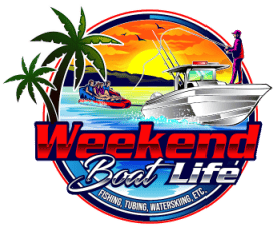
Weekend Boat Life
Boat Navigation Lights: What You Need to Know
This post contains affiliate links.

I have always found that driving my boat at night can present many challenges and definitely can create some added stress. Seeing other boats and hazards on the water at night is very difficult. This will require you to use lights to help you view; however, I’m not speaking of flashlights. I’m speaking about navigational lights made specifically for boating.
Navigating the waters safely requires understanding the critical rules for navigation lights on boats . Boats under power must have red and green side lights and a white stern light visible in all directions. This rule applies to almost any boat you might operate on the water.
Knowing and following these navigation light requirements ensures you’re easily seen by other boaters when you’re sailing at night or in poor visibility. Powerboats and sailboats have specific light configurations they must adhere to, such as a white masthead light and red and green sidelights for boats under 23 feet.
Understanding these rules not only keeps you compliant with maritime regulations but also enhances the safety of every journey you undertake. I will discuss this in detail, but for additional guidance, you can explore resources like BoatUS Foundation’s navigation lights guide or gain insights from Discover Boating’s comprehensive article .
Overview of Boat Navigation Lights
I have found that being out on the water at night, away from the city lights, can cause pitch-dark conditions. Navigation lights are essential for the safety of vessels navigating at night or in poor visibility conditions. They help prevent collisions by ensuring vessels are visible to one another and inform skippers of the type and direction of nearby boats.

Purpose and Importance
As previously mentioned, navigation lights are designed to prevent collisions at sea by making vessels visible to each other. White lights, red lights, and green lights are specifically configured to communicate a vessel’s position and operational status. The color of the lights can determine which way the boat is moving, regardless of whether it’s currently under power.
White lights are located on a vessel’s stern and operate as all-around lights for powerboats. Red and green lights denote port and starboard sides, helping other vessels understand your direction and size. Without these lights, other boaters would have difficulty seeing you at night. These lights are crucial for safe boating at night and in poor visibility, alerting others to your presence and movement.
Legal Requirements
To ensure maritime safety, all vessels must adhere to specific laws and regulations concerning navigation lights, which the USCG mandates . These rules vary depending on the size of the boat you’re operating.
For example, powered boats under 39.4 feet need one all-around white light visible for two miles and side lights (red and green) visible for one mile. Vessels at anchor must display a white light visible from all directions. These regulations aim to standardize vessel visibility and identification, reducing the risk of collisions.

General Types of Navigation Lights
Various types of navigation lights are used depending on the vessel and its activity. These lights have certain locations on the boat where they must be located. The primary lights include:
- Masthead light : A white light positioned over the fore-and-aft centerline of the vessel. These lights are used on sailboats, an example of a highly-rated masthead light is here .
- Sidelights : The red light is located on the port side, while the green light is on the starboard side. The picture at the beginning of the article is an example of these lights. On my boat I use something similar to this.
- All-around light : A light showing an unbroken light over an arc of 360 degrees. This light must be operational while the boat is moving and also if the boat is anchored in the water. For my boat I use a simple light that is attached to a pole.
Powerboats, sailboats, and anchored vessels use these lights differently to convey their specific operating conditions. Proper navigation lights are essential for night-time or low-visibility boating to prevent accidents and ensure compliance with regulations.

Pactrade Marine Waterproof LED Combo Masthead And Deck Light Vertical Mount For Sailboat Boats Up To 12M, G4 Type Bulb and LED Type
What We Use

Obcursco Boat Bow Navigation Lights, Marine LED Navigation Light Ideal for Pontoon, Skiff, and Small Boat

attwood 5610-48-7 Telescoping Pole Light, All-Around Light, Height-Adjustable 26-42 inches, 2 Mile 360-Degree Visibility, One Size
Navigation light placement and visibility.
Proper placement and visibility of navigation lights are required by law and essential for the safe operation of boats . Different types of vessels require specific light configurations to ensure they are visible to others on the water, especially in low-visibility conditions.

Placement on Vessels
Navigation lights must be correctly placed to comply with maritime regulations. For powered boats under 39.4 feet, an all-around white light should be visible from all directions and must be placed at least 39 inches above the sidelights. The red port sidelights and green starboard sidelights at the bow of the boat need to cover an arc of 112.5 degrees and should be visible from one nautical mile away.
Visibility Ranges
The visibility range requirements for navigation lights vary depending on the type of vessel and light. For boats over 65 feet but under 164 feet, the masthead light must be visible from five nautical miles. Non-masthead lights, such as stern lights and all-around lights, must typically be visible for at least two nautical miles. Smaller boats, particularly those under sail, often use a combination of a masthead light and sidelights to ensure they are seen from appropriate distances.
Exceptions and Special Cases
Different rules apply in particular cases. Vessels at anchor must display an all-around white light visible for at least two nautical miles. I really enjoy viewing the 4th of July fireworks from my boat. Unfortunately, many boaters turn all their lights off to view the fireworks. This is an extremely dangerous thing to do, as it can cause issues for other boats moving in the area.
Additionally, sailboats have unique requirements; when under sail, they use port and starboard lights , along with a white stern light. Small sailboats under 65 feet may use a tricolor masthead lantern to combine the navigation lights into one fixture, visible over the required arcs and distances.
These regulations ensure that each vessel is equipped with the proper lights, making navigation in the dark safer for everyone on the water.

Operation and Maintenance of Navigation Lights
Proper operation and maintenance of navigation lights are essential for safe boating , especially during times of reduced visibility. I have had to replace my lights several times over the years, just due to wear and tear. You must ensure you frequently check that your lights are in working order.
Operating Lights in Reduced Visibility
Just as lights are important to use at night, when your vessel is underway in reduced visibility conditions such as fog or heavy rain, it is also crucial to display the appropriate navigation lights to avoid collisions. Ensure that your white stern light is visible from the correct arc.
If you are motoring, your vessel must have an all-around white light and green and red sidelights. For sailboats under sail, displaying a tricolor light at the masthead helps other vessels identify your position. Anchored boats should exhibit an all-round light.
Keeping a flashlight handy can be an extra layer of safety, allowing you to signal other vessels in emergencies. Use your navigation lights at the correct intervals and arcs consistent with maritime regulations to indicate your vessel’s maneuverability and right of way.

Maintaining and Troubleshooting Navigation Lights
Regular maintenance of navigation lights ensures their reliability. Periodically check that all your all-around lights, side lights, and stern lights are functioning correctly.
Replace any burned-out bulbs immediately. I always suggest carrying spare bulbs on board. One overlooked thing, at least for me, is cleaning the lenses regularly to ensure maximum visibility. Also, don’t forget to inspect the wiring for any signs of wear or corrosion and repair as needed.
When troubleshooting issues, first verify that the power source is intact and the circuits are functioning. If lights remain faulty, consult your vessel’s manual or contact a marine electrician. Keeping your navigation lights in good working order prevents mishaps and underscores your commitment to safe boating practices.

Frequently Asked Questions
Navigation lights on boats are essential for safe operation and compliance with maritime regulations. This section provides specific information about the requirements for different vessels.
What are the required navigation lights for vessels under international regulations?
International regulations mandate that vessels must display specific navigation lights. These include a white masthead light, red and green sidelights, and a white stern light for power-driven vessels. Sailboats have slightly different requirements, especially when under sail alone.
What are the specific navigation light requirements for small boats?
Small boats, generally those under 65 feet, must display red and green sidelights and a white stern light. If the vessel is under 23 feet, it may also need an all-around white light visible in all directions. Details on this can be found on the BoatUS Foundation .
What colors and positions are mandatory for navigation lights on boats?
Mandatory colors include red for the port side, green for the starboard side, and white for the stern and masthead lights. Positioning is critical: sidelights must be placed on the appropriate sides of the vessel, and stern lights must be positioned at the rear.
How do navigation light requirements differ at night compared to daytime?
These requirements are primarily for nighttime or low-visibility conditions. During the day, the emphasis is more on shapes and signals rather than lights. However, any vessel operating from sunset to sunrise must display the appropriate lights.
What regulations apply to the placement of navigation lights on vessels?
Regulations specify that lights must be placed at certain heights and angles to ensure visibility. For example, a powerboat’s masthead light must be at least one meter above the sidelights. More details are available at the U.S. Coast Guard Navigation Center .
How do rules for navigation lights vary for different sizes and types of boats?
The rules can vary significantly. For example, sailboats under 65 feet can display a tricolor light at the masthead when under sail. Powerboats and smaller vessels may have simpler setups. More information can be found on the Discover Boating website .
Similar Posts

Must-Have Gear: 10+ Boating Essentials for Safe and Fun Boating
From life jackets to navigation tools, our guide outlines the boating essentials every boater should have for safe and fun outings. Dive into our comprehensive checklist before your next voyage.

Top 5 Boating Mistakes and How to Avoid Them
This post contains affiliate links.Boating is fun and delightful for families, but it also comes with…

Night Boating: Navigating the Dark
This post contains affiliate links.Navigating the waters after the sun sets presents a unique set of…

Port vs Starboard: What’s the Difference?
This post contains affiliate links.Navigating a ship, plane, or spacecraft can be challenging, especially when left…

Choosing the Perfect Pleasure Boat: Understand Your Options
This post contains affiliate links.Boating is a fun way to enjoy the water and spend quality…

Beginner’s Guide to Boating: The Essential Tips
New to boating? Our Beginner’s Guide offers crucial tips to help you get started, stay safe, and enjoy your time on the water.
Leave a Reply Cancel reply
Your email address will not be published. Required fields are marked *
Save my name, email, and website in this browser for the next time I comment.

Boat Navigation Light Rules Explained (For Beginners)
Boat navigation light rules can be a little difficult for newcomers to understand. This is probably because these light rules can change depending on a wide variety of factors.
Failing to comply with these rules can leave you open to enforcement violations as well as lawsuits.
Also, knowing these rules will help keep you and other boaters safe while out on the water, so you must learn and remember them.
Here’s everything you should know about the boat navigation light rules.
Table of Contents

Why Have Boat Navigation Light Rules At All
Boat navigation light rules help boaters communicate with each other. They also help to determine who has the right of way. This is important as it determines what actions boats will take as they pass one another.
Without these guidelines, there would be many more accidents out on the water as people wouldn’t know how to interact.
Remember, when you’re out on the open water, there aren’t any designated lanes to follow, and without rules, boaters can easily become confused about which way they should turn or whether or not they should even turn at all.
On top of this, these rules help establish methods for boaters to tell each other when they’re anchored or when they’re in distress. Use your lights correctly when you need help, and you’re much more likely to get it.
When do I Need to Follow Boat Navigation Light Rules?
Light rules apply any time between sunset and sunrise. They also apply any time visibility is low.
An example of this could be during foggy or rainy weather.
A more unusual example of this could be during a solar eclipse. Basically, if you feel that having the lights on will help others see you better, it’s a good idea to turn them on.
The Different Light Rules by Boat and Size
Different types of boats will have different light rules that they need to follow. These sets of rules are broken down based on whether the boat is a sailboat or a powered boat.
Once this is established, the rules are then broken down by size.
The different sizes to consider are boats shorter than 39.4 feet, boats sized between 39.4 and 65.6 feet, and boats greater than 65.6 feet.
If you’re wondering why the numbers are so precise, it’s because this is the conversion from meters. 39.4 feet equals 12 meters, and 65.6 feet equals 20 meters.
Generally, all boats will have a red light on their port side and a green light on their starboard side. To put it in plain English, if you’re in the driver’s seat, the red light goes on the left, and the green light goes on the right.
A white light should be at the stern of the boat. The stern is the rear of the boat.
Powered Boat Light Placement

Here are the lights you’ll need when operating a powered boat, depending on the size of the boat you’re operating.
- Boats less than 12 meters or 39.4 feet long:
You’ll need one red light and one green light at the front port and starboard sides of the boat for these boats. These lights should be positioned so that they can be seen at an angle of 112.5 degrees. The sidelights should be strong enough to be seen from a mile away.
You’ll also need to mount them towards the bow of the boat. This is otherwise known as the front of the boat.
Additionally, you’ll need one white light that can be seen from all angles. It should be strong enough to be seen from two miles away.
This light will need to be mounted at least 39 inches or 99 centimeters higher than the red and green lights.
- Boats greater than 12 meters or 39.4 feet but less than 20 meters or 65.6 feet:
With boats of this size, you’ll still need your red and green lights, but your white lights will change.
In this case, you’ll mount a red light to your port or left side and a green light to your starboard or right side. These lights will need to be seen from an angle of 112.5 degrees, and they’ll need to be seen from a distance of one mile.
The two white lights will need to be mounted at the stern and masthead of the boat. Stern lights can also be referred to as the aft light. Either way, it just means the light at the back of the boat.
This light will need to be seen from a 225-degree angle facing the rear. It needs to be strong enough to be seen from 2 miles away.
The masthead light is at the forward position of the boat. This light is mounted on the masthead, and it must cover a 135-degree angle.
The light will need to be visible from 2 miles away.
Masthead lights must be mounted at least 8 feet above the gunnel. The gunnel is the top edge of the side of the boat.
- Boats larger than 20 meters or 65.6 feet long:
To operate a non-commercial boat over 20 meters or 65.6 meters long, you’ll have to have the same lights in the same positions as the smaller boats. However, you’ll also need to add matt black inboard screens to your sidelights.
Sail Boats and Other Unpowered Boats

These boats can be broken down into two different size categories.
These two categories are under 23 feet or 7 meters and boats that are over 23 feet or 7 meters.
Unpowered boats such as sailboats, rowboats, and kayaks under 23 feet in length only need to have a white light on them. This white light can be anything from a flashlight to a lantern.
However, you can still opt to place red and green lights at their appropriate places.
Larger sailboats will need to have a 135 degree white light at the stern and 112.5 degree red and green lights at the port and starboard sides. The white light should be visible from 2 miles away, while the red and green lights should be visible from 1 mile away.
Alternatively, a tri-color light could be placed on the masthead.
This light will have all three lights built into it, and it should be visible from at least 2 miles away.
Advice For All Boats Regarding Light
Regardless of what boat size you’re on, it is a good idea to have a flashlight with you.
If your boat lights become inoperable, you’ll at least have one light that you can signal with.
Should you find yourself on the water at night in a disabled boat , your flashlight may be the only thing keeping you from being crashed into.
Light Rules For Boats at Anchor
When you’re anchored at a marina or dock, you won’t have to worry about specific boat light rules and regulations.
However, when you’re anchored out on the water, you must follow boat light rules as this will help keep other boaters from running into you.
It will also help establish that you have the right of way so you won’t have to move every time a larger boat comes your way.
Of course, having the right lights doesn’t mean you’ll be able to anchor just anywhere. You’ll still have to follow any inland rules when it comes to anchoring your boat.
When anchored, you’ll need to display an all-around white light that lets other boaters know your position. This light should be placed where other boaters can best see it. For example, a sailboat might put this light at the top of its mast. Also, another all-around white light might be placed near the deck to help identify your anchored boat to nearby boats.
Boats Under Distress
Boats under distress should display what is known as a visual distress signal so that they can get help. At night, these distress signals will come in flares, parachute flares, and lights.
You should have at least three devices on your boat to use for signaling.
This could come in a variety of forms, and you can use the same one three times. For example, your three devices could be having three signaling flares with you.
Only use these lights when you’re in danger. Failure to do so can result in heavy fines and potential imprisonment.
Determining Who Has The Right of Way
When you come across another boat, and you can only see a white light, then you’ll know that you’re either approaching an anchored vessel or a vessel that is moving in front of you. In this case, you can overtake them and go around them from either side.
If you come across a green light and a white light, then you have the right of way. In boating terms, this means that you are the stand-on vessel.
Technically speaking, the other boat should give way, and you won’t have to worry about changing your course.
However, there is always a chance that the other person will not give way for some reason, and you should be ready to move. You never know, the other boater may not see you, or they may not know the rules as they should. Remember, being right won’t mean anything if you end up dead in a boat crash.
If you come across a red and white light, you are the one that needs to give way. In this case, you’ll want to slow your boat down and pass by them, probably behind their path.
In all of these scenarios I described, you were in a powered vessel, and you were passing a powered boat or a sailboat that was driving while under power.
However, what happens when you encounter a sailboat or other unpowered vessel in a powered vessel?
In this case, you’ll see a red light, a green light, or a white light, but you won’t see all three. Regardless of what you see, you’ll want to give way. This is because these boats can’t maneuver as well as you, and they probably won’t be able to get out of your way before you come across them.
At this point, you can see why different boats need different types of lights and why it’s important to use the lights that apply to your particular craft. Use the wrong lights, and you’ll confuse the other boaters around you. This could easily lead to an accident that could have easily been avoided.
What About Boaters Who Are Color Blind?
Unfortunately, people who are color blind won’t safely operate a boat at night by themselves.
Also, they won’t be able to get a captain’s license as you need to pass a color blind test to get this license. Here’s an article we wrote about all you need to know about boat license types (with prices) .
If you’d like to do some recreational boating at night, but you can’t differentiate between the colors red and green, you might want to consider bringing a friend along.
This way, your friend can tell you what colors you’re coming up on so that you can safely navigate yourself past other boats.
4 Types of Boat Lights
- The red and green lights that go on the sides of a boat are known as sidelights.
- White lights that only face backward are known as stern lights, and white lights that face forward are known as masthead lights.
- An all-round white light is a white light that faces 360 degrees. These lights are used on smaller boats and on boats that are at anchor. They can be replaced by making use of a stern light and a masthead light.
- Another type of light is the tri-color light. A tri-color light can be used on a sailboat to portray the white, green, and red lights. Bi-color lights are also available for small powered boats and sailboats. These lights display both red and green light.
The combination of lights that are displayed will always give the boater a 360-degree field of light.
This ensures that other boaters can see them no matter where they are in relation to each other.
Safety Precautions To Be Aware Of
Even new boats can have lights that weren’t configured correctly or lights that don’t work.
It’s important that you check these lights before you head out on the water.
This is true even if you don’t intend on staying out after dark. After all, it’s always possible that you could become stranded until after dark or that it could become too foggy to operate out on the water without lights.
Other Things You Should Know About Boating At Night
Boat navigational light rules are critical for nighttime boating, but there are other things to consider as well.
One thing to consider when boating at night is the use of a lookout.
Having one of your passengers act as a lookout will make it more likely that you’ll spot problems in advance.
Remember, other boaters aren’t the only potential hazards you can run into at night. Shallow shipwrecks, low water depths, and unlit piers, docks, and jetties can also become hazards if they aren’t noticed in time for you to avoid them.
High beams should be used for docking purposes only. This is because using them while on the water can confuse other boaters.
Also, the high beams can shine into other sailor’s eyes and can give them night blindness.
Just think about it this way.
It isn’t safe to drive towards another car with your high beams on, so why would it be safe to drive towards another boat with high beams on?
Driving Speed
Nighttime boating should be done at slower speeds than day time boating. The primary reason for this is that visibility is more limited at night.
Driving slower will help to give you more time to react to boaters and other hazards.
When you first start boating, you’ll still have to take a moment to think about the lights you see. Driving at a slower speed will give you this additional time without affecting your safety.
Not All Lights On The Water Are Boats!
I’ll end this post with a funny story I once heard about a boat traveling at night. This story has changed many times over the years, but the gist of it’s still the same.
It goes like this:
A large vessel was traveling at night when they came across a white light in front of them. The ship captain immediately got on the radio and contacted the other vessel to demand that they get out of the way.
The other vessel responded by telling the captain to change his course. To this, the captain responded with, “This is the warship, the USS Enterprise, and I demand you change course, or we’ll be forced to take action!”.
To this, the other vessel responded with, “This is a lighthouse, and you are on course to become shipwrecked.”.
This isn’t a real story, and now that you know proper boat navigation light rules, it is a story that could never happen to you.
If you came across a white light and thought it was a boat, you’d assume it was unpowered or at anchor, and you’d take steps to go around it.
Click to share...

Boat Navigation Light Rules: Sail Safely at Night
- Post author: [email protected]
- Post published: December 23, 2023
- Post category: Maritime
- Post comments: 0 Comments
Boat navigation light rules are essential for preventing collisions at night or in poor visibility conditions. These regulations dictate the color, position, and timing of lights displayed by boats.
Navigation lights serve two main purposes on a boat. They are the definite way to make your boat visible when you operate it at night or in low visibility weather to prevent collusion. The other thing is when two boats approximate each other, the navigation light indicates who has in the right way. However, these lights will only come in handy when you make the best use of them with navigation light rules. In this post, we’ve covered the basic rules for navigation lights.
Navigating waterways safely after dark requires a clear understanding of maritime lighting norms. Established by international and local maritime organizations, these rules mandate that vessels exhibit specific lights to indicate their size, type, and activity to other boaters—assuring clarity on the waters when visibility wanes.
Green lights denote the right side, red lights signal the left side, and white lights reveal a vessel’s presence and direction. Sailboats under power and all motorized boats must follow these guidelines to communicate their intentions and maintain safety at sea. Adherence to these protocols helps to prevent accidents and is a fundamental component of responsible boating. By mastering these rules, boaters contribute to a safer nautical environment for everyone navigating the waters.
Boat Navigation Light Rules – Key Takeaways
- Colored lights are always denoted as sidelight, Red light on the Port, and Green on the starboard. Red and green sidelights both shine from dead ahead to 112.5° aft (towards the stern) on each side.
- Stern lights are white and shine towards the stern (aft) and 67.5° forward on both sides. (Therefore, the stern light combined with the sidelight creates a full (360°) circle of light.
- All-round lights are white and shine constantly over the horizon by creating an arc of 360°.
- Masthead lights are white and installed over the fore and aft centreline on a vessel. This provides an unbroken light over an arc of the horizon of 225° forward, which signifies 112.5° on the port side through just ahead to 112.5° on the starboard side.
- Sailboats under power are recognized powerboats.
- During the day sailboats with sails up, but are also under power, are required to fly a black “steaming cone,” with its point downward, wherever it can be viewed. When a sailboat is under power it must follow the rules as like a powerboat.
Types Of Boat Navigation Lights
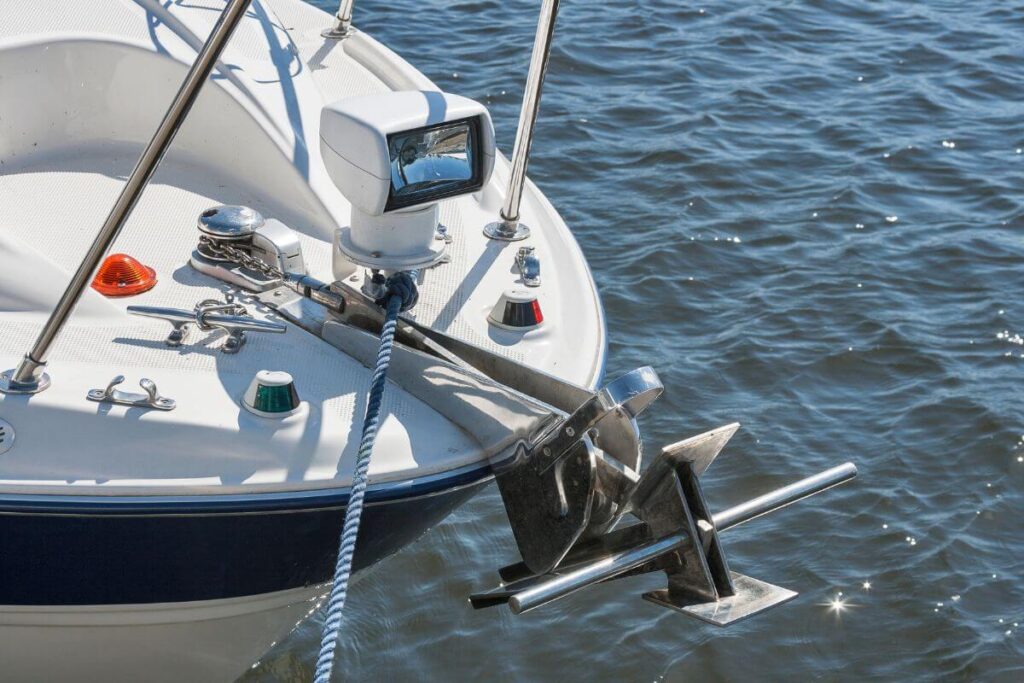
Navigating the waters safely means understanding the language of marine lighting. Just as traffic lights regulate the flow of cars, boat navigation lights help sailors avoid collisions and travel securely after dark. We’ll explore the essential lights that every seafarer needs to recognize.
Port (red) Navigation Lights
The left side of a vessel, referred to as the ‘port’ side, is designated by a red navigation light. This luminary serves as a positional marker, allowing other boaters to ascertain which direction a vessel is facing in relation to their own when meeting head-on or crossing paths.
- Visible from a distance, typically up to one nautical mile for smaller boats and two nautical miles for larger vessels.
- Should remain illuminated from sunset to sunrise and during periods of restricted visibility.
Starboard (green) Navigation Lights
On the opposite side, the ‘starboard’ side is indicated through a green navigation light. Its purpose mirrors that of the port light—to inform nearby boats which side they are seeing to prevent accidents.
- Similar in range to the red port light, starboard lights also span up to two nautical miles for larger vessels.
- Must be in operation from dusk until dawn and at times when visibility is poor.
Stern (white) Navigation Lights
Completing the critical trio of navigation lights is the stern light, a white light placed at the back of the boat. This light ensures that vessels are visible from behind and can safely be overtaken or crossed.
- Shines over a prescribed arc and is clearly visible over two nautical miles.
- Crucial during night hours and in low-visibility conditions, this light is a non-negotiable aspect of navigation safety.
Familiarity with these navigation light regulations is vital for all boaters to maintain safety and comply with international maritime laws. By following these guidelines, mariners can signal their intentions and position effectively, ensuring safer seas for everyone.
Rules And Regulations
Understanding the rules and regulations for boat navigation lights is crucial for ensuring the safety and compliance of maritime travel. Both international waters and inland waterways have distinct sets of regulations that sailors must adhere to. Navigation lights help in the prevention of collisions by alerting other vessels of your position, orientation, and status. This section provides a detailed overview of the regulations that govern boat navigation lighting.
International Rules
The International Regulations for Preventing Collisions at Sea (COLREGs) dictate the use of navigation lights for vessels on international waters. According to these rules:
- Power-driven vessels require a masthead light, sidelights, and a stern light.
- Sailing vessels under power must use the lighting configuration of power-driven vessels. When solely under sail, they should display sidelights and a stern light.
- Vessels at anchor display an all-round white light visible from all directions.
- Vessels under 7 meters may have reduced requirements in certain conditions.
All vessels must adhere to the specific color, range, and arc requirements for each light, ensuring visibility by other boats.
Inland Rules
For boats navigating in rivers, lakes, and other inland waterways, the United States Coast Guard (USCG) sets out their own rules which are:
- Different configurations for navigation lights are based on the type and size of the vessel.
- Rules for specific waterway types and conditions, including peri-urban waterways with increased traffic .
- Mandatory compliance with local and federal regulations which could involve additional lighting or signals .
The Inland Navigation Rules act in unison with COLREGs but have localized adjustments for the increased complexity of shallow and narrow channels.
Additional Considerations
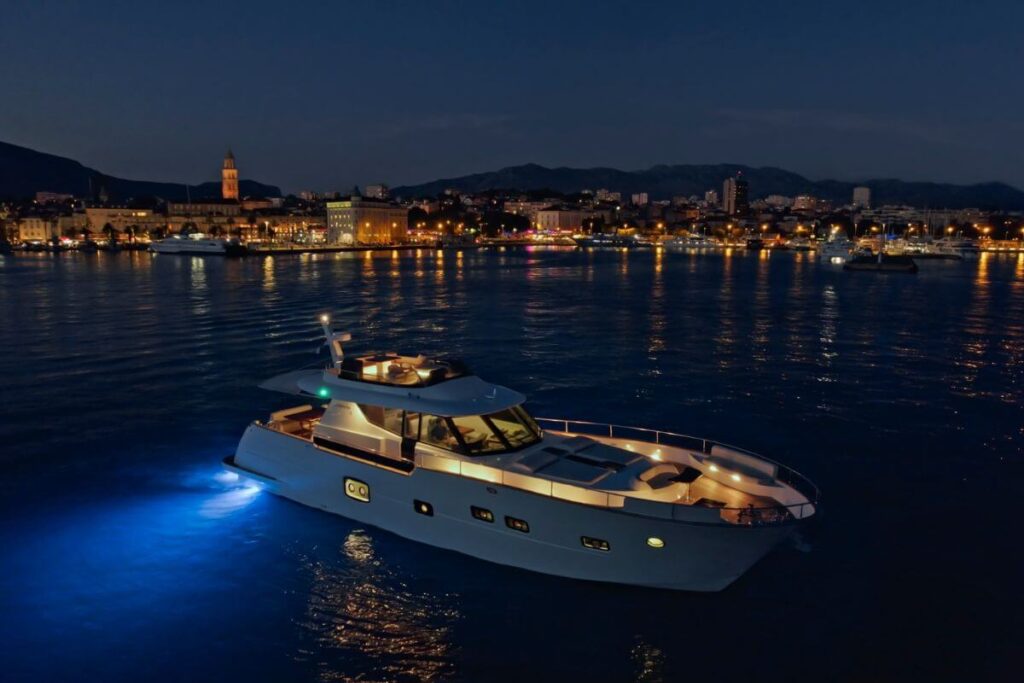
Beyond the standard regulations, there are additional considerations to keep in mind:
| Vessel Condition | Lighting Requirement |
|---|---|
| Restricted in ability to maneuver | All-round lights to indicate status |
| Engaged in fishing | Specific lights that signal other boats to keep clear |
| Towing operation | Additional lights to indicate towing length and breadth |
Proper interpretation and application of navigation light regulations are essential. Skippers should ensure their vessels comply with the latest regulations and be prepared to recognize the light configurations of other vessels to maintain safety on the water .
Frequently Asked Questions For Boat Navigation Light Rules
What are the requirements for navigation lights on a vessel.
Vessel navigation light requirements vary by size and type. All boats must display red (port) and green (starboard) sidelights. Power-driven vessels over 12 meters need a masthead light, sternlight, and all-around white light. Sailing vessels under 7 meters may use a lantern or flashlight in low visibility.
What Lights Are Required For Boats At Night?
At night, boats must display red and green sidelights and a white stern light. Boats under sail also need a red-over-green masthead light. All vessels are required to exhibit an all-round white light when at anchor.
What Are The Rules For Nautical Lights?
Nautical lights are governed by specific rules to ensure safety and communication at sea. Vessels must display lights that indicate their size, type, and activity. Red and green sidelights denote port and starboard, while white stern and masthead lights show direction and visibility to other ships. Compliance with the International Regulations for Preventing Collisions at Sea (COLREGs) is mandatory.
What Navigation Lights Are Required For Boats Under 23 Feet?
Boats under 23 feet need red and green sidelights and an all-round white light or a masthead light and sternlight visible from two miles away. Use sidelights in conjunction with the masthead and sternlight or the all-round white light.
Navigating the waters safely is essential for any boater. Understanding and following the boat navigation light rules is a key part of this. Ensuring your vessel is visible at night and during poor visibility conditions protects you and others at sea.
Navigation lights are the way to describe your position and movement in the water. By installing these lights and knowing the rules you can ensure the safety of your vessel and everyone else.
You Might Also Like

Electric Vessels | Future of The Most Advanced Shipping Industry

Autonomous Ships | Future of Maritime Industry
Leave a reply cancel reply.
Save my name, email, and website in this browser for the next time I comment.
Boat Boat Go
Love Boat Party Life

What Lights Are Required on a Boat at Night? A Guide to Navigation Lights
Boating at night can be a thrilling experience, but it can also be dangerous if proper precautions are not taken. One of the most important safety measures boaters need to be aware of is the use of navigation lights. Navigation lights are required on all boats when operating between sunset and sunrise, or in conditions of reduced visibility.
Table of Contents
Understanding Boat Navigation Lights
Boat navigation lights are an essential part of boating safety, especially when sailing at night or in low visibility conditions. These lights serve as a communication tool between boats, indicating their position, direction, and status.
To understand boat navigation lights, it’s important to know the different types of lights and their meanings. The following table summarizes the different types of lights and their characteristics:
| Light Type | Color | Arc of Visibility | Location |
|---|---|---|---|
| Masthead Light | White | 225 degrees | Centerline of the boat |
| Sidelights | Red (port) and Green (starboard) | 112.5 degrees | Port and starboard sides of the boat |
| Stern Light | White | 135 degrees | Aft end of the boat |
The masthead light is a white light that is placed centerline on the boat, showing an arc of 225 degrees with 112.5 degrees on either side of the front of the vessel. This light indicates the presence of a boat and its direction of travel.
Sidelights are a pair of lights, with one red light on the port side and one green light on the starboard side. These lights must show an arc of 112.5 degrees from the centerline of the bow. The sidelights indicate the direction of travel of the boat and help other boats determine the boat’s orientation.
The stern light is a white light that is placed at the aft end of the boat, showing an arc of 135 degrees. This light indicates the presence of a boat and its direction of travel.
Boats under 12 meters in length may combine the sidelights and stern light into one fixture, while boats under 7 meters may use a handheld light instead of the required lights.
It’s important to note that navigation lights must be visible at a sufficient distance to prevent collisions. The exact visibility requirements depend on the size and type of the boat.
Types of Navigation Lights
When operating a boat at night, it is essential to have the right navigation lights to ensure safety and avoid collisions. Navigation lights are classified into four types: stern lights, bow lights, masthead lights, and all-round lights.
Stern Lights
Stern lights are white lights located at the back of the boat. They are essential for indicating the position of a vessel to other boats approaching from behind. The stern light should be visible from at least two miles away and should be placed at a height that ensures it is visible from all directions.
Bow lights are red and green lights located at the front of the boat. The red light should be on the port (left) side of the boat, while the green light should be on the starboard (right) side. These lights help other boats determine the direction of the vessel and prevent collisions.
Masthead Lights
Masthead lights are white lights located at the top of the mast. They are visible from all directions and help other vessels determine the size and type of the boat. Masthead lights should be visible from at least two miles away and should be placed at least 1 meter above the sidelights.
All-Round Lights
All-round lights are white lights that can be seen from all directions. They are used to indicate the position of a vessel when it is not under command or when it is anchored. All-round lights can be mounted on a mast or on the top of the cabin.
Legal Requirements for Boat Lights
Boat lights are required by law to ensure the safety of all watercraft and passengers. The legal requirements for boat lights are set by the Collision Regulations, which specify the types, colors, and locations of lights that must be displayed on boats of different sizes and types.
For example, power-driven boats under 39.4 inches in length must display navigation lights from sunset to sunrise. These lights must include side lights, a masthead light, and a stern light. Sailboats operating under engine power are also considered power-driven and must follow the same rules.
Boats over 39.4 inches in length must display additional lights, such as a towing light or an all-around white light. The exact requirements vary depending on the size and type of boat, as well as the operating conditions.
The table below summarizes the legal requirements for navigation lights on boats in the United States:
| Boat Size | Required Lights |
|---|---|
| Under 12 meters (39.4 feet) | Red and green sidelights, white masthead light, and stern light |
| 12 to 20 meters (39.4 to 65.6 feet) | Same as above, plus an all-around white light |
| Over 20 meters (65.6 feet) | Same as above, plus additional lights for towing, pilotage, and other purposes |
It is important to note that these are minimum requirements, and boaters are encouraged to go above and beyond to ensure their safety and the safety of others on the water. This might include using additional lights or reflectors, or taking other precautions such as reducing speed or avoiding crowded areas.
In addition to the legal requirements for boat lights, boaters should also be aware of the rules of the road for navigating on the water. This includes understanding the right of way, signaling intentions, and communicating with other boats using lights, horns, or other means. By following these rules and regulations, boaters can help ensure a safe and enjoyable experience on the water.
How to Use Navigation Lights Properly
Navigation lights are an essential tool for keeping boaters safe at night or in times of reduced visibility. Proper use of these lights is crucial to prevent collisions and ensure safe passage. Here are some tips on how to use navigation lights properly:
- Always make sure that your navigation lights are in good working condition and turned on when required.
- Know the required lights for your vessel size and type, as well as the rules for displaying them. Refer to the relevant regulations for your area.
- Display the correct lights for your vessel’s activity. For example, if you are anchored, you should display an anchor light.
- Make sure that your lights are visible to other vessels. Keep them unobstructed and at the proper height and angle.
- Use your navigation lights in combination with other safety measures, such as radar and AIS, to increase your visibility and awareness of other vessels.
- Avoid shining bright lights, such as spotlights, in the direction of other vessels as it can impair their vision and cause confusion.
- Take extra care when navigating in areas with heavy traffic or poor visibility. Slow down and keep a lookout for other vessels.
Common Mistakes and How to Avoid Them
When it comes to navigation lights on a boat, there are a few common mistakes that boaters make. Here are some tips on how to avoid them:
1. Failing to Turn on Navigation Lights
One of the most common mistakes boaters make is failing to turn on their navigation lights. Navigation lights are required from sunset to sunrise and during periods of reduced visibility. It is important to turn them on as soon as visibility becomes poor or when the sun sets.
2. Using Incorrect Navigation Lights
Another mistake that boaters make is using incorrect navigation lights. Each boat has specific requirements for navigation lights based on its size and type. It is important to know the legal requirements for your boat and to ensure that you have the correct lights installed.
3. Improper Placement of Navigation Lights
Navigation lights should be placed in the correct location on the boat. For example, the masthead light should be placed centerline on the boat showing an arc of 225 degrees with 112.5 degrees either side of the front of the vessel. Sidelights should be placed on the port and starboard sides of the boat and must show an arc of 112.5 degrees from centerline of the bow.
4. Not Checking Navigation Lights Regularly
Navigation lights should be checked regularly to ensure that they are working properly. It is important to check them before every trip to make sure that they are functioning correctly. If a light is not working, it should be replaced immediately.
5. Not Having Backup Navigation Lights
Finally, it is important to have backup navigation lights on board in case the primary lights fail or become damaged. Flashlights can be used as backup lights in case the navigation lights burn out or become damaged.
By avoiding these common mistakes, boaters can ensure that their navigation lights are functioning properly and that they are following the legal requirements for their boat.
Maintaining Your Boat’s Navigation Lights
Proper maintenance of a boat’s navigation lights is crucial for ensuring the safety of the vessel and its passengers. Here are a few tips to help keep your navigation lights in good working condition:
- Regularly inspect the lights for any damage or wear and tear. Replace any broken or damaged lights immediately.
- Check the wiring and connections regularly to ensure they are secure and free of corrosion. Corroded connections can cause the lights to malfunction or fail altogether.
- Clean the lenses of the lights regularly to ensure maximum visibility. Dirt or grime on the lenses can obscure the light and reduce its effectiveness.
- Test the lights before each trip to ensure they are working properly. This includes checking the brightness, color, and direction of the light.
- Replace the bulbs as needed. It is recommended to carry spare bulbs on board in case of a bulb failure.
In conclusion, navigation lights are an essential safety feature for any boat that operates at night or in reduced visibility conditions. They help to ensure that other boats can see and avoid collisions with your vessel.
Related posts:
- How Fast Can A Boat Go Depending On Horsepower?
- How Far Can You Transmit with a 25 Watt VHF Radio? Explained
- Why Height Matters: Importance and Benefits of a VHF Radio Antenna
- The Legalities of Bringing Your Dog on a Boat: Understanding Local Regulations
Terms and Conditions - Privacy Policy

Service Locator
- Angler Endorsement
- Boat Towing Coverage
- Mechanical Breakdown
- Insurance Requirements in Mexico
- Agreed Hull Value
- Actual Cash Value
- Liability Only
- Insurance Payment Options
- Claims Information
- Towing Service Agreement
- Membership Plans
- Boat Show Tickets
- BoatUS Boats For Sale
- Membership Payment Options
- Consumer Affairs
- Boat Documentation Requirements
- Installation Instructions
- Shipping & Handling Information
- Contact Boat Lettering
- End User Agreement
- Frequently Asked Questions
- Vessel Documentation
- BoatUS Foundation
- Government Affairs
- Powercruisers
- Buying & Selling Advice
- Maintenance
- Tow Vehicles
- Make & Create
- Makeovers & Refitting
- Accessories
- Electronics
- Skills, Tips, Tools
- Spring Preparation
- Winterization
- Boaters’ Rights
- Environment & Clean Water
- Boat Safety
- Navigational Hazards
- Personal Safety
- Batteries & Onboard Power
- Motors, Engines, Propulsion
- Books & Movies
- Cockpit Confessions
- Communication & Etiquette
- Contests & Sweepstakes
- Colleges & Tech Schools
- Food, Drink, Entertainment
- New To Boating
- Travel & Destinations
- Watersports
- Anchors & Anchoring
- Boat Handling
Anchor Light Requirements
USCG anchor light requirements for inland waterways.
Advertisement
The Inland Rules have specific requirements as to anchor lights. That rule is quoted below, as is the USCG site reference.
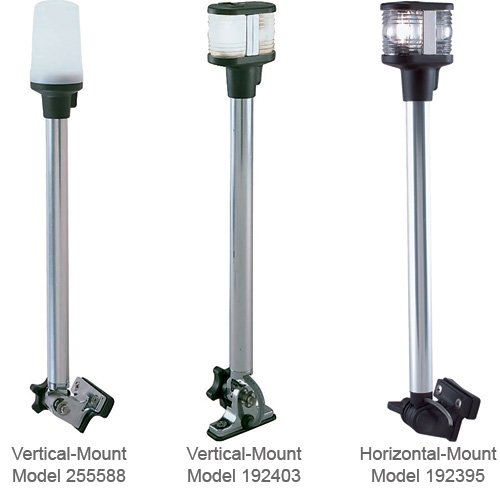
A 360-degree white all-around masthead light with two-mile visibility normally fulfills this requirement for most pleasure boats, but familiarize yourself with and follow the rule. Wire gauge, length of wiring, connections and battery condition can affect a light's performance. Follow manufacturer's instructions to ensure compliance with U.S. Coast Guard regulations. If you have one of the newer LED anchor lights, it may not be as bright as earlier lights. Be sure that the manufacturer specifies in writing that it meets USCG requirement.
Displaying a proper anchor light when anchored at night isn't merely a matter of law. It's a matter of safety for you and others. Even if the boat is in a known or designated anchorage area, dinghies and other boats may be traveling in that area and will need to know the location of your boat. People have been severely injured and killed because a skipper decided that he'd not burn an anchor light.
Following is Rule 30 of the Rules found here .
Rule 30 - Anchored Vessels and Vessels Aground
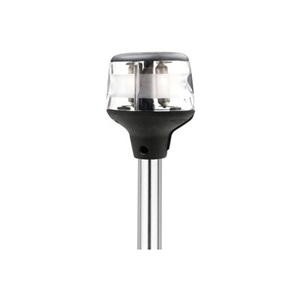
(a) A vessel at anchor shall exhibit where it can best be seen:
(i) in the fore part, an all-round white light or one ball;
(ii) at or near the stern and at a lower level than the light prescribed in subparagraph (i), an all-round white light.
(b) A vessel of less than 50 meters in length may exhibit an all-round white light where it can best be seen instead of the lights prescribed in paragraph (a) of this Rule.
(c) A vessel at anchor may , and a vessel of 100 meters and more in length shall, also use the available working or equivalent lights to illuminate her decks.
(d) A vessel aground shall exhibit the lights prescribed in paragraph (a) or (b) of this Rule and in addition, if practicable, [Inld] where they can best be seen;
(i) two all-round red lights in a vertical line;
(ii) three balls in a vertical line.
(e) A vessel of less than 7 meters in length, when at anchor not in or near a narrow channel, fairway or where other vessels normally navigate, shall not be required to exhibit the shape prescribed in paragraphs (a) and (b) of this Rule.
(f) A vessel of less than 12 meters in length, when aground, shall not be required to exhibit the lights or shapes prescribed in subparagraphs (d)(i) and (ii) of this Rule.
(g) A vessel of less than 20 meters in length, when at anchor in a special anchorage area designated by the Secretary, shall not be required to exhibit the anchor lights and shapes required by this Rule. [Inld]
Related Articles
The truth about ceramic coatings for boats.
Our editor investigates the marketing claims of consumer-grade ceramic coatings.
Fine-Tune Your Side Scan Fishfinder
Take your side-scanning fishfinder off auto mode, and you’ll be spotting your prey from afar in no time
DIY Boat Foam Decking
Closed-cell foam flooring helps make boating more comfortable. Here’s how to install it on your vessel
Click to explore related articles
BoatUS Editors
Contributor, BoatUS Magazine
Award-winning BoatUS Magazine is the official publication of Boat Owners Association of The United States. The magazine provides boating skills, DIY maintenance, safety, news and more from top experts.
BoatUS Magazine Is A Benefit Of BoatUS Membership
Membership Benefits Include:
Subscription to the print version of BoatUS Magazine
4% back on purchases from West Marine stores or online at WestMarine.com
Discounts on fuel, transient slips, repairs and more at over 1,200 businesses
Deals on cruises, charters, car rentals, hotel stays and more…
All for only $25/year!
We use cookies to enhance your visit to our website and to improve your experience. By continuing to use our website, you’re agreeing to our cookie policy.
Boat Reviews
- Boats Specs
- Marine Pros
- Boat Insurance
- Boat Warranties
- Boat Transport
- Boat Towing
- Marine Forecasts

Your Ultimate Boating Resource

What are the proper sailboat lights at night?
As a sailor, it is essential to be aware of and adhere to proper sailboat lighting when navigating at night. These lights are necessary to ensure safety and avoid collisions with other vessels.
The International Regulations for Preventing Collisions at Sea (COLREGS) specifies lighting requirements for different types of boats. There are different lighting rules for vessels under power and those under sail. In this article, we’ll discuss the proper sailboat lights at night.
Sailboats are required to have three lights at a minimum: a masthead light, a red port light, and a green starboard light. The masthead light is white and is located at the top of the mast. This light should shine forward and aft and be visible from 2 nautical miles away. It is important to ensure that the masthead light is not obstructed by the sail or any other structure onboard.
The red port light is located on the left or port side of the boat and is visible from 1 nautical mile away. The green starboard light is on the right or starboard side and is also visible from 1 nautical mile away. These lights should shine out from the vessel and be visible from dead ahead to 112.5 degrees abaft the beam on either side.
In addition to these lights, sailboats that are underway may show an optional stern light. This light is placed at the stern of the vessel and is white. It should be visible from 2 nautical miles away and can be used to indicate that the sailboat is underway and not at anchor.
If a sailboat is not underway but still poses a potential hazard, it should display an anchor light. This is a white light that is visible from 2 nautical miles away and should be located near the top of the mast. This light indicates that the sailboat is anchored and should be avoided by other vessels.
It is important to note that the visibility of the lights depends on the weather and other conditions. In foggy or hazy conditions, the lights may not be visible from the specified distance. It is always a good idea to maintain a lookout and be aware of other vessels in the vicinity.
Proper sailboat lighting at night is critical to ensuring safety and avoiding collisions with other boats. It is essential to understand the required lighting regulations and to ensure that all lights are functioning correctly before heading out on the water. Remember to always maintain a lookout and be aware of other vessels around you. Happy sailing!
Related Questions
What type of wood is used for pier pilings, what is the difference between a dock and a floating pier, what is the proper technique for pulling a beginner wakeboarder, what does ‘no wake’ mean on a lake, what is the difference between wash and wake, is wakesurfing possible in the sea, why don’t wooden piers rot, what size wakeboard is needed, how to achieve more pop on a wakeboard, does wake surfing translate to ocean surfing, latest posts, overview of the 2024 sea-doo rxp-x 325, overview of the 2024 parker offshore 2900 cc, what your boat’s beam is and why it matters, power cats of 2024: ultimate guide to the top power catamarans this year, don't miss, our newsletter.
Get the latest boating tips, fishing resources and featured products in your email from BoatingWorld.com!
Navigating the Heat: 10 Safety Tips for a Safe Boat Ride in the Summer Heat
Highs, lows, and tidal know-how: a deep dive into ocean currents, 10 essential tips for fishing near private property, the benefits of using a drift sock: guidance for anglers, lure fishing: secrets for imitating live bait and attracting fish, explore the untapped depths of america’s best bass fishing spots, outboard motor maintenance: tips for keeping your engine in top shape, the essential boat tool kit: tools every boater needs, diy boat building: 8 tips and tricks for building your own vessel, the art of miniature maritime craftsmanship: ship in a bottle, antifouling paints: a guide to keeping your boat shipshape, beginner’s guide to standup paddle boarding: tips and techniques, boating for fitness: how to stay active on the water, kayak safety: how to stay safe on the water, anchoring in a kayak or canoe: how to secure your small boat, overview of the 2024 yamaha 252sd, overview of the 2024 tiara yachts 48 le, overview of the 2024 bass cat jaguar sts, 2024 pursuit os 445: an overview, 2024 aquila 47 molokai review, 2024 sea-doo switch 13 sport review, gear reviews, megabass oneten max lbo jerkbait review, fortress anchors fx-7 anchoring system review, fortress anchors fx-11 anchoring system review, fortress anchors commando anchor kit review, fortress anchors aluminum anchors review, stay in touch.
To be updated with all the latest news, offers and special announcements.
- Privacy Policy

What Lights Are Required On A Boat At Night?
Feb 1, 2022
By Stephen Plash
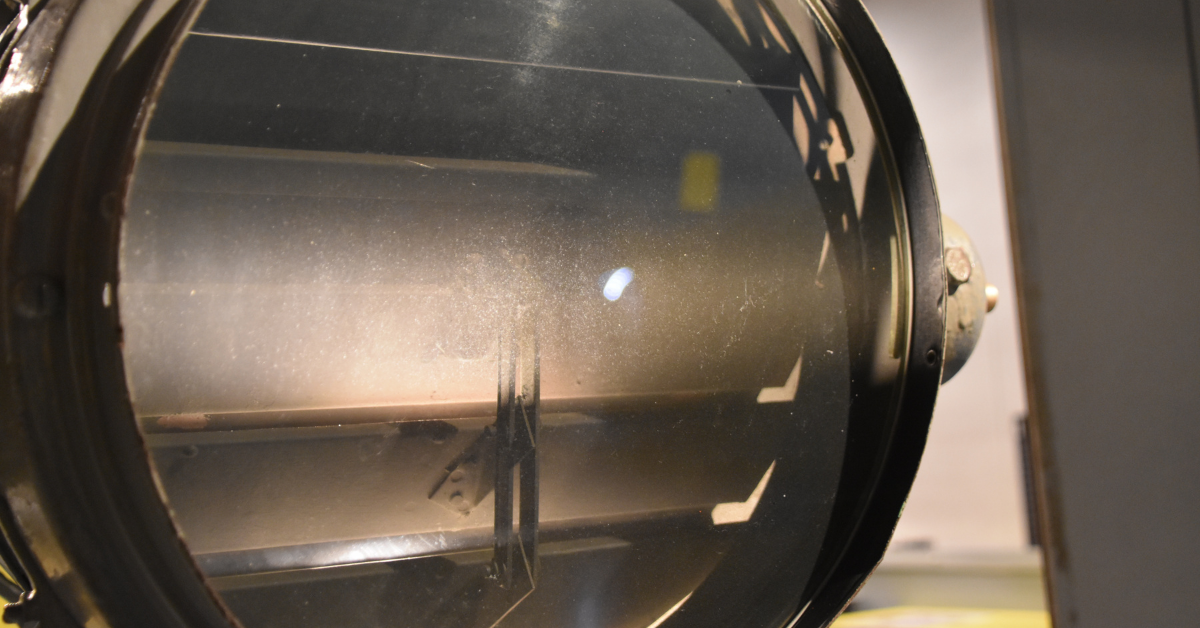
Now that 2022 is here, the boating season is fast approaching. This means that it’s time to start preparing your boat and ensuring you have all the necessary gear and that all boat light requirements are met. The requirements depend on the size of the vessel, and PlashLights offers marine lighting of all kinds, including:
- Accent & Deck Lights
- Marine Light Bars
- Spreader & Flood Lights
- Underwater/Transom Lights
- Handheld LED Spotlights
We want to help you make sure your vessel is ready to go for your next boat day!
Boat Light Requirements
One of the foremost boat light requirements is navigation lighting. The type of light requirements changes for each vessel because the bigger the boat, the more powerful and visible the lights need to be.
Powerboats and Sailboats When Under Power
One of the basic rules of navigation lights is that sidelights, a masthead light, and a stern light are required.
- Powerboats less than 12m (39.4’) can substitute a single all-around light for separate masthead lights and a stern light.
- Powerboats and sailboats under power that are less than 20m (65.7’) can substitute a single bi-color light for the sidelights.
Note that Sailboats operating under engine power are considered power-driven and must follow the “Under Power” rules.
Sailboats When Under Sail
Sidelights and stern light are the basics required. There are variations to this rule that are also allowed.
- Sailboats less than 20m (65.7’) can substitute a tricolor light for separate sidelights and stern light. A bi-color light with a stern light may also be substituted.
- Sailboats less than 7m (23’) can exhibit lights like explained above. An alternative that is also accepted is to have a ready-at-hand electric torch or lighted lantern (flashlight) that shows white lights in enough time to prevent a collision.
- Sailboats, during the day, that are under power with sails hoisted are required to show a motoring cone with its apex pointed down.
Oar-Driven and Paddled Vessels (Rowboats, Kayaks, Canoes)
- Vessels that are rowed or paddled may exhibit the lights for a sailboat. Keep a ready-at-hand electric torch or flashlight that shows white light in enough time to prevent a collision.
Vessels at Anchor
- When a vessel is anchored at night outside a designated anchorage, an all-around light visible from at least 2m is required.
- During the day, an anchored vessel must display a black anchor ball.
Minimum Visibility Range
- Boats less than 12m (39.4’), sidelights are required to be visible for at least 1nm. The rest of the lights must be visible from at least 2nm.
- Vessels less than 20m (65.7’), a masthead light must be visible for 3nm. All other lights must be visible from 2nm.
- Boats over 20m (65.7’) but less than 50m (164’) should display a masthead light visible for 5nm. The rest of the lights should be visible for 2nm.
Note that a copy of the Navigation Rules and Regulations must be kept on board at all times for boats greater than 20m (65.7’).
Shop With Us
While regulations require boaters to have the standard U.S. Coast Guard-approved lights, our PlashLights team offers additional marine lighting of all kinds. Our LED lighting systems are not only top quality and come with a lifetime warranty, but they also keep you safe and visible to other boaters while you navigate darker waterways. Much like high beams while driving, we recommend turning off any light bar or spotlight when you see other boats so you do not blind or obstruct other boaters.
Each of our marine lights is meant to add to the safety of your boating experience, especially at night. With the legally required lights, plus even one of our LED light bars , you’ll be one of the brightest and safest boats on the water.
Contact PlashLights today for more information on all our marine lighting or our marine LED light bars!
Reading next

Choosing the Correct Wire Gauge for your 12V LED Lights
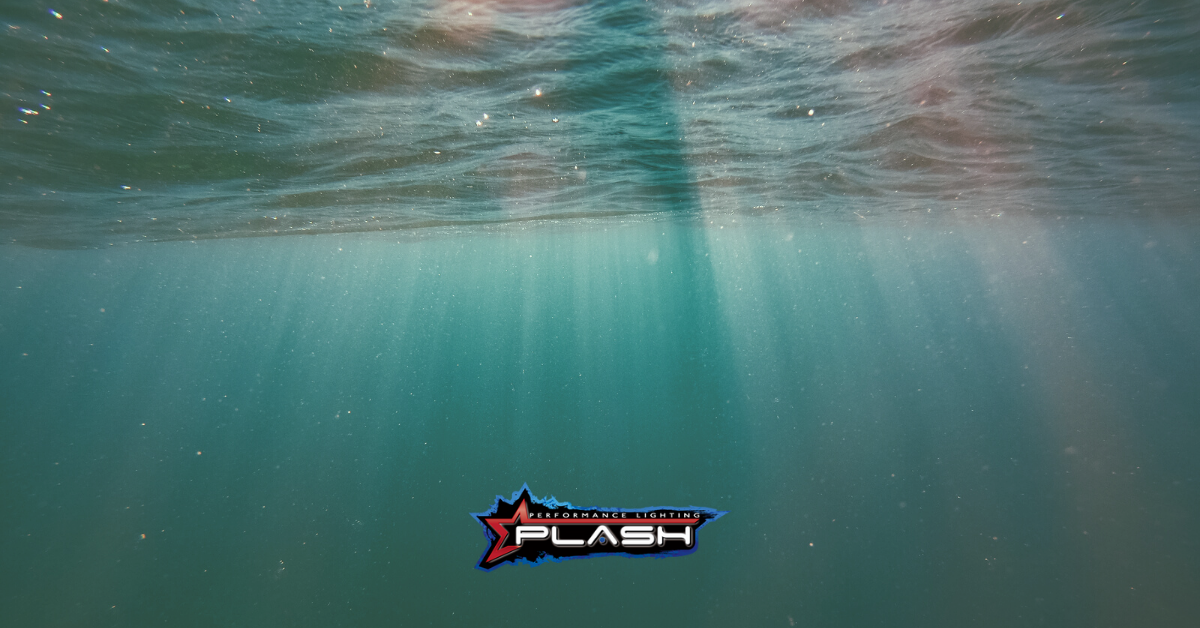
Benefits of Underwater Lights
Leave a comment
This site is protected by reCAPTCHA and the Google Privacy Policy and Terms of Service apply.

Navigation Lights - See & Be Seen
Foundation findings #48 - january 2010, in 1990, the boatu.s. foundation evaluated running lights, judging color, intensity, and arc of illumination. running lights, which are generally installed by manufacturers, are coast guard certified for color, arc of illumination and distance..
Since it has been nearly 20 years since our initial test, we wanted to take a fresh look and evaluate the visibility of a typical recreational boat's running lights at the distances for which they were rated, and we also wanted to look at LED lights, which were not available for our first test.
There is no requirement for a boat manufacturer to install running lights on modern boats, but if they do they must use US Coast Guard (USCG) certified fixtures and installed per regulations. However, it is ultimately the boat owner's responsibility for the proper display of navigation lights and owners should take note if purchasing a used boat, especially if fixtures have been moved to accommodate additions like T-tops or bow pulpits. At the end of the day, it is your responsibility to be certain your lights are positioned properly and are the proper intensity for your sized boat. To see USCG minimum requirements, click here (opens in new window).
We tested more than two dozen weather products on the market - everything from cellular phone text messaging to Sirius satellite weather on a chart plotter. For the purpose of this test we did not examine offshore communication methods such as satellite phones, Inmarsat or weather fax products but focused on weather products available to inshore and near coastal boaters at nominal prices.
In both tests, we found that even properly installed, Coast Guard certified lights can blend with background lights from other geographic features or get lost in the myriad of other possible light sources often called "backscatter." Sometimes backscatter even reflects off the water, making it difficult to determine exactly how many lights you are seeing. Reports of these challenges, as well as complaints about glare may leave many wondering if there are easy solutions to help the average recreational boater "see and be seen."
This test did not compare manufacturer's products head-to-head. Instead, we evaluated the lights that came factory-installed on our 11-year-old center console test boat. We then replaced them with a handful of new lenses, new fixtures, and some readily available portable LED lights to see what simple modifications can be made to improve the visibility of your boat at night, and to reduce on-board glare that can affect nighttime operators.
Test Background - Do You See What I See?
The Findings test focused on observations relying on the naked eye and spoken commentary from our volunteer test subjects. Observers ranged in age from the mid-twenties to mid-fifties. One observer was color blind. All are boaters and have previous nighttime experiences on the water. Our tests were not vision tests per se, nor were they intended to specifically verify manufacturers' claims. Rather, the tests focused primarily on visibility - more precisely, determining whether the lights could be easily recognized and identified at the distance for which they were intended.

A nearly full moon presented more problems than expected when light reflected off the rippling water causing observers to question what they were seeing.
On the night of our testing, we had calm sea and wind conditions, a nearly full moon, and good visibility. Ideal conditions for nighttime boating and one would think, for nighttime observations and testing. We found, however, that with such calm and clear conditions, running lights and navigational aids reflected off the water, literally causing us to see double at times. The moon cast light on the water, and its reflections were multiplied by ripples and boat wakes. The lights of houses, docks, bridges - even passing cars also further distracted our observers.
It is worth noting, however, that our observations may have been significantly different on a pitch black night-or out at sea.
We set out to answer these simple questions - how well can you see the light at various distances? What factors played a role in a boat's visibility? Navigation lights are barely visible at night from a distance.And is there anything within reason that can be done to improve visibility so that others can see you and you can see them?
To carry out our test, we anchored a large power boat as our observation platform. Our test boat, a 22' center console power boat, had a combination red and green light mounted on the bow and an all 'round white light mounted on a 12" pole on top of the T-top. We outfitted each fixture with pin fittings so we could quickly connect and disconnect the various lights. We then moved the test boat 0.5 mile, 1 mile, 2 miles and 3 miles away from the observation boat and recorded feedback from the observers at each interval.

We evaluated each of the following products:
- The original lights that came standard with our eleven-year-old boat. Perko, bi-color $35.99. white $62.99 (The plastic lenses had an obvious weathered and slightly clouded look during a close-up visual inspection.)
- The original lights with new replacement lenses that cost about $15 for each fixture. Perko, bi-color $12.49, white $14.99
- A new single bulb LED light fixture Attwood, bi-color $52.99, white $96.98
- Portable multiple bulb LED fixtures for both the bow and stern light - NaviLight, bi-color $49.99, white $49.99*
- Portable Navigation Lights for small boats less than 7 knots - Aqua Signal, bi-color $34.99, white $34.99**

*NaviLight portable lights require 3 "AAA" batteries. Not Coast Guard certified, but meets lighting requirements for boats under 12 meters (39'). **AquaSignal portable lights require 4 "AA" batteries and are for use on crafts less than 7 meters (22 ft.) in length and a maximum speed of 7 knots (8 mph).
A Word About LEDs
Relatively new to most consumers and far from standard on boats are LED (light emitting diode) lights. Though you've seen them on your stereos, TVs, DVD players and just about any remote control for years, consumer fixtures are a relatively new application for LEDs. Using semiconductor technology, these lights present many advantages over incandescent lights, especially for boaters.

According to experienced cruisers, the primary draw of LED lights on a boat is that LEDs are more energy efficient. They draw less energy and have a long life expectancy, which makes them great for anchor lights. The same bi-color light at night.They also generate less heat and are directional in output, providing a narrow beam of light perfect for a flashlight or a reading light fixture. However, this directional output means that a single LED cannot effectively fill the required arc of a navigation light or the requirement for an all 'round 360 degree light. Fortunately, newer multi-bulb LED fixtures have emerged on the market to help achieve the arc effect.

There are of course larger LED fixtures on the market but we didn't evaluate them as our focus was on the smaller recreational boat. LED arrays clearly have their advantages. 2 white stern lights side by side. LED on the Right and a traditional incandescent bulb on the left.Their low-energy draw makes them ideal for anchoring and thereby extends battery and alternator life. LED bulbs are also long lasting and have sealed circuitry. Manufacturers often claim 50,000 hours of useful life and some offer warranties up to 10 years. The only disadvantage is that the cost of the fixtures may not seem to pay for itself initially. But down the road, it could pay dividends. And seeing and being seen by other boaters is, well, priceless.
Although LEDs are comparatively more expensive, we were curious if there was a visible difference when compared to standard incandescent lighting fixtures. We tested these fixtures both on the water and with a light meter in an indoor controlled setting.
The original lenses on our test boat had become clouded over the years, and were observed as being "washed out." A yellow colored light meter is used to test the luminosity of a white stern light.At 2 NM, the green light looked white and at 3 NM, white looked "reddish" according to some observers. As expected, by simply replacing the 11-year-old cloudy lenses with new lenses, observers reported that the lights could be seen much better. The white light benefited the most with a new lens. The red and green were greatly improved too and the color was truer at all distances.
Next, we replaced the fixture with the new lenses with a brand-new red/green combination LED fixture. We selected a readily available fixture that used a single red and a single green LED bulb behind a clear lens. Various manufactures have stated that a white LED bulb behind a colored lens is not recommended. (Typically, navigation light fixtures use a traditional white filament bulb behind colored lenses.)

At close range and up to 0.5 mile, the LED lights looked brighter and crisper, with some commenting that the white light looked somewhat blue, almost like a fluorescent overhead street lamp on shore. At greater distances, testers agreed the white LED sometimes got lost in the backscatter, but up close without the confusion of backscatter, the white LED light had a distinctive look. This is due to how LED lights are made-a white LED bulb doesn't emit the same type of light as a traditional bulb, and the light doesn't appear as 'warm' or natural as a traditional bulb.
A Bright Finish - Multi-LED Fixture
We hesitated to purchase any light that was not Coast Guard certified for our evaluation. But when an email from a parts retail supplier literally arrived the day we were headed out on the water, announcing the arrival of a new LED navigation light, we stopped by to pick it up. The NaviLight uses an array of 16 tiny individual bulbs to complete the required arc of illumination. This fixture was also portable, requiring just 3 AAA batteries.
Mutli-bulb LED fixtures are not new in the transportation and retail world. You see them in brake lights on cars and lighted signs for businesses. Some larger boats even have multi-bulb LED fixtures, but they cost hundreds of dollars. Our NaviLight setup cost about $100 for both the bi-color and white light, so we hoped that investment would prove valuable. And to our delight, it performed very well - a real surprise since the product targets the operators of small marine craft like tenders, dinghies and paddle craft.
On average, this fixture outperformed every light fixture we evaluated. At close range, one observer stated that the lights were "big", meaning their aura was large. And at 3 NM, another observer stated that the red and green LEDs were almost as bright as the large government maintained red and green lighted Aids to Navigation.

A note about color:
There are four critical factors that determine the distances at which light can be seen: the intensity of the light (candlepower), its color (chromaticity), the height of the light above the water, and your height above the water. Green is the easiest color to see at night. Red is used for navigation lights because its wavelength is the longest of all colors and it is easily recognized by the naked eye.
Some Final Thoughts
A boat's running lights tell much about the night time operation of a vessel. For example it can indicate if the vessel is a sail boat or power boat, if you're looking at its starboard or port side, or if its coming or going. For larger boats, lights can indicate certain commercial maneuvers such as if a vessel is tugging or pushing a barge, if it's engaged in commercial fishing or dredging, or if it is aground or at anchor. Recognition and maintenance of these lights is paramount to everyone's safety on the water.
For as much as running lights can tell you about a boat and its operation, there's much that can't be gleaned from a passing glance. For example, it is often difficult to determine the true direction and range of another boat. When operating at night, the same Navigation Rules apply as well as the Coast Guard requirement for maintaining a proper look out and operating at a safe speed. Taking bearing readings on other objects and vessels is also important and could mean the difference between a near miss and a safe passage.

Your eyes need anywhere from 12 to 40 minutes to fully adapt to the dark after exposure to bright light. Boating at night requires preparation, focus and concentration. Here are some additional tips to make your nighttime outing a safe one.
It Goes Without Saying:
- Maintain a proper lookout
- Reduce your speed at night
- Follow the Rules of the Road
- Always wear a properly fitted PFD
- Get well rested before nighttime operation
- Let your eyes adjust properly to the conditions
- Never consume alcohol prior or during operation
- Extinguish other lights that might contribute to night blindness
Tips to Reduce Onboard Glare:
Night blindness is sometimes caused by the operator's own vessel. Your boat should be set up so that on board lighting does not interfere with safe nighttime operation.
- If you have any doubt, be certain your light fixtures are mounted properly per Coast Guard requirements. For example, an all 'round white light should be 1 meter higher than the red and green fixture.
- An all 'round white light is often mounted on a pole to meet the requirement above. For most runabouts, a removable pole mounted light ranges from 4" to over 4'.
- Stern lights should not "spill" or allow stray light into the cockpit. However, an aftermarket glare shield resembling a pie-plate placed underneath an all 'round white light can greatly reduce on board glare.
- Light fixtures should also be mounted such that chrome grab rails, cleats and other shiny surfaces don't reflect light back into the operator's eyes. A temporary fix is to place black electrical tape on shiny surfaces to prevent reflection.
- Check to see if lighted instruments and electronic navigation equipment can be dimmed. Our GPS Chartplotter had a nighttime display mode that cut glare by over 50% when measured by a light meter.
Tips to Increase Visibility
In our observations, we were able to make some general conclusions about the products and have compiled a list of tips that can help visibility when operating a boat at night.
- Assure that all fixtures are working properly by checking prior to departure and replace any burned out bulbs. You should always carry a spare or two.
- Clean all light lenses with something soft once a season. Grime and insects can sometime build up on the inside too.
- Inspect lenses for fading, crazing, or cracks that might affect light output. Our eleven-year-old lenses were cloudy, reducing overall effectiveness.
- Replace any broken or faded lenses with new ones. This is a simple fix and it really makes a difference.
- Be certain light fixtures are mounted properly. The white stern light should be placed high enough so that it does not cause operator blindness.
- On average, LED lights were more visible than comparable incandescent fixtures. Although more expensive, LED lights draw less energy and have a much longer life expectancy.
Basic Requirements for Small Boats
In general, a boat is required to display navigational lights from sunset to sunrise and in or near areas of reduced visibility. While underway, no other lights may be displayed that could be confused for a navigation light.
For power boats under 12 meters (39 feet) the red and green sidelights (or combination red/green single fixture) must be visible for 1 nautical mile (NM) and the all 'round white masthead light or stern light must have a visible range of 2 NM. This includes sailing vessels under power and motor sailing.
Boats larger than 12 meters but less than 20 meters (39-65 feet) have a 2 NM requirement for side lights, a 2 NM requirement for stern light and 3 NM requirement for masthead light. A sailboat under sail alone does not have the 3 NM requirement for the masthead light. At anchor, both power and sail less than 65 feet must have a 2 NM all 'round white light. For an interactive lighting requirement diagram check out the Coast Guard's Navigation Center.
- 2024 BOAT BUYERS GUIDE
- Email Newsletters
- Boat of the Year
- 2024 Freshwater Boat and Gear Buyers Guide
- 2024 Boat Buyers Guide
- 2024 Water Sports Boat Buyers Guide
- 2024 Pontoon Boat Buyers Guide
- Cruising Boats
- Pontoon Boats
- Fishing Boats
- Personal Watercraft
- Water Sports
- Boat Walkthroughs
- What To Look For
- Watersports Favorites Spring 2022
- Boating Lab
- Boating Safety
- Ultimate Boat Giveaway

Guide to LED Pontoon Boat Lights
- By Elliott Stark
- August 20, 2024
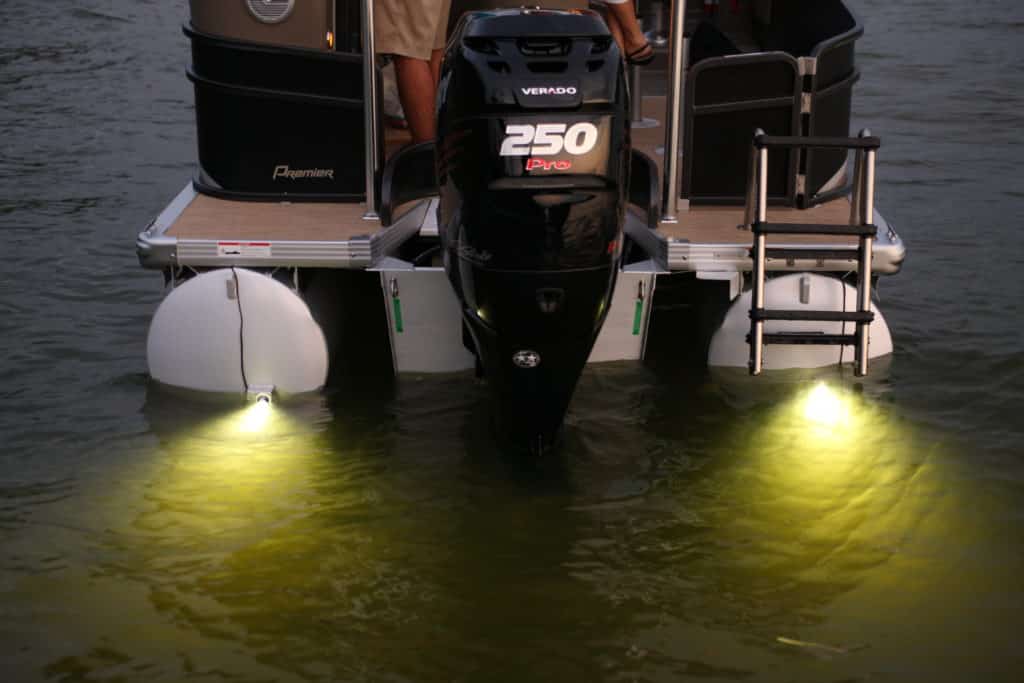
Whether on the lake, river or bay, nothing packs a party quite like a pontoon boat. Recent advancements in LED lighting take the pontoon boat party to a whole new level. What follows is our take on dialing in your pontoon boat led lighting setup.
What Lights Does a Pontoon Boat Need?
Like all vessels, the right pontoon boat LED lighting setup involves a combination of lights that you’re required to have and those that make the experience more fun. Whether navigation lights, spreader bars, underwater lighting or light strips around the deck, LED lights are functional, versatile and quite a bit of fun.
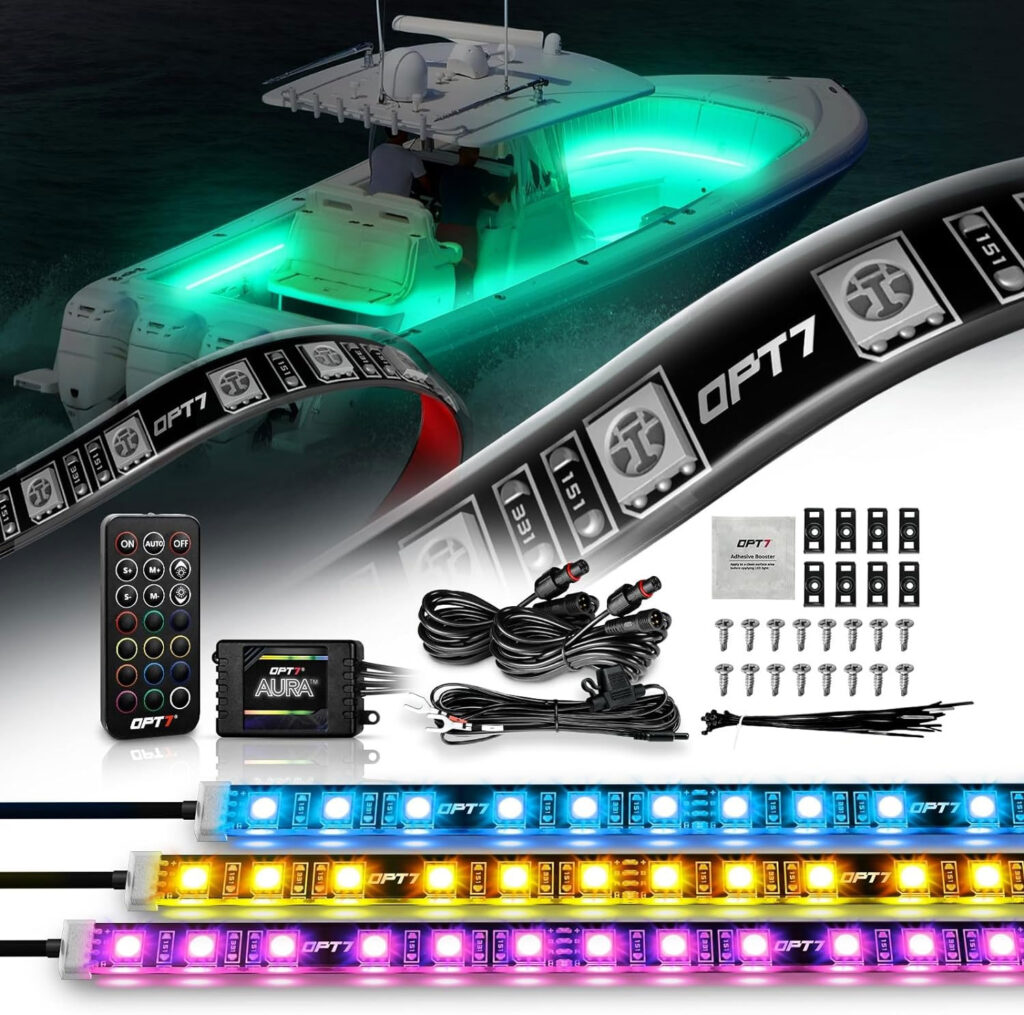
LED setups offer a number of customization possibilities. For instance, they may be:
- Dimmable: You can control and adjust the brightness and lumen output via apps on your marine electronics or smartphone.
- Multi-color changing: The same bulb can produce an incredible variety of colors. Previous lighting options, if they had the ability to change color at all, were extremely limited.
- Syncable with sound: With the right setup and installation, you can make the lights on your pontoon boat change in brightness and color to music. LED light strips like these are really cool for kids and adults alike.
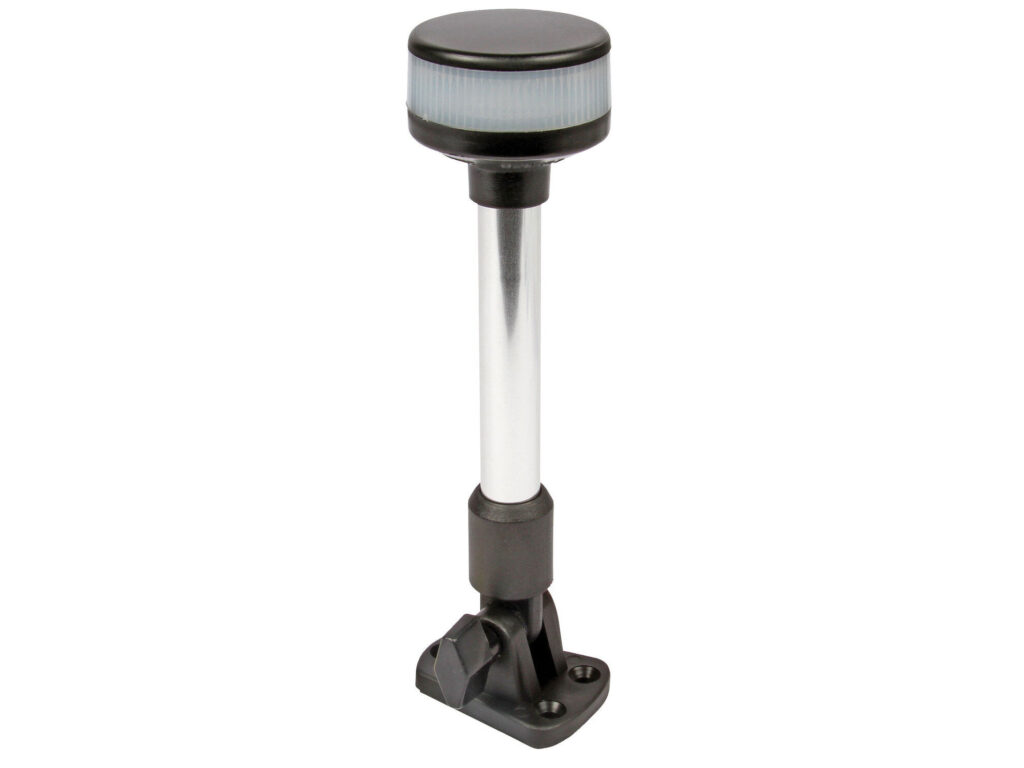
Lighting for Pontoon Boats: Legal Requirements
The exact lighting setup you will need depends on the length of your pontoon boat. Be sure to check the legal requirements for your situation. The requirements include the number of lights, angle of light emitted, and visible range of the light.
At its most basic, your pontoon boat needs the following:
- Masthead lights: These are typically white lights that are mounted in a place that is visible to other boats. This base-mounted, fold down LED pole light is a great example.
- Navigation lights: These are the classic red and green lights mounted on the bow of your boat. In addition to being required by law, they let other vessels know which direction you are traveling at night.
- Stern lights : You also need stern lights mounted on the back of your boat and an all-around light.
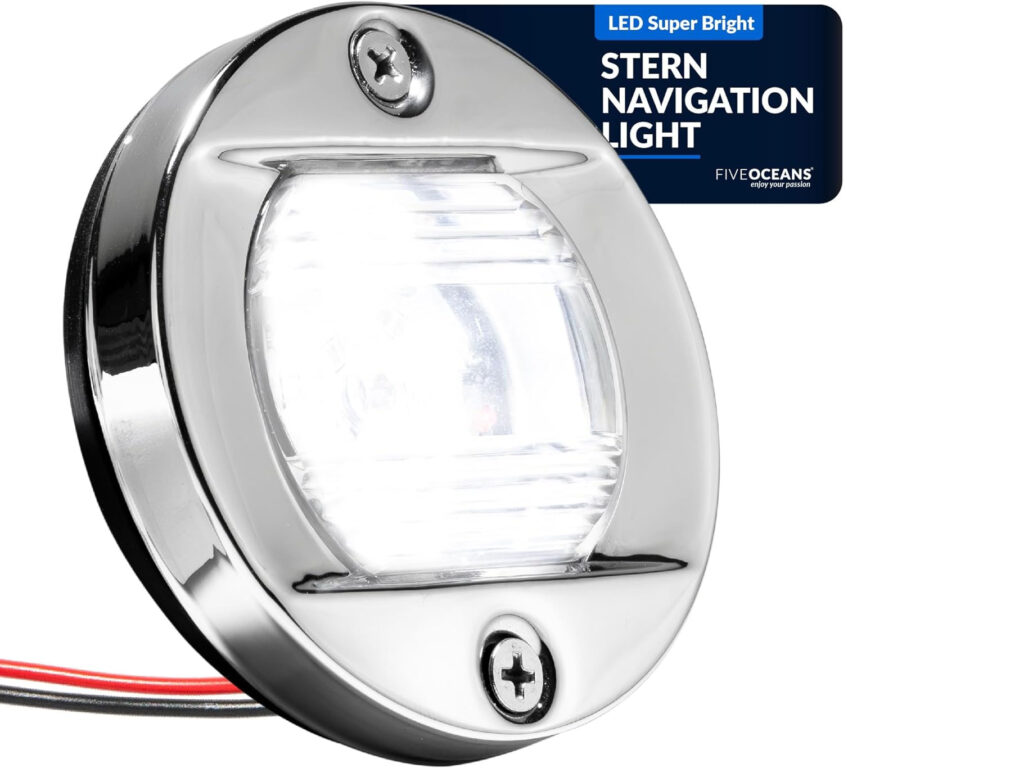
‘Nice-to-Have’ Lights for a Pontoon Boat
Beyond the lights required by law, you can outfit your pontoon with an incredible variety of exciting LED lighting options. Consider illuminating the dock, installing courtesy lights along pathways and steps, and adding submersible underwater LED lights .
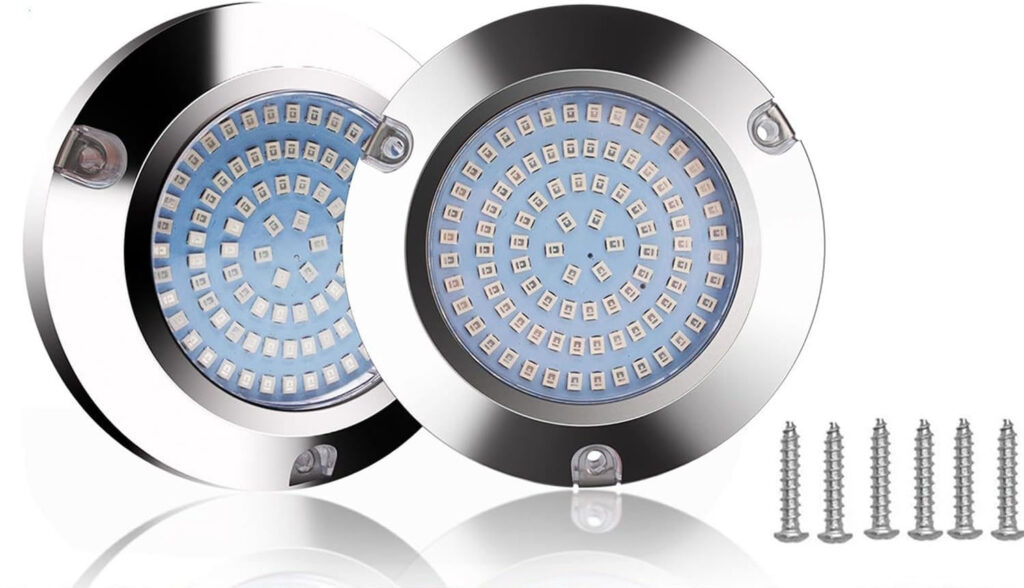
You also have many options when it comes to deck lighting. For instance, you can mount a series of recessed LED lights along the walls or beneath the covering boards. You can also mount an LED light strip to run the length of your pontoon boat.
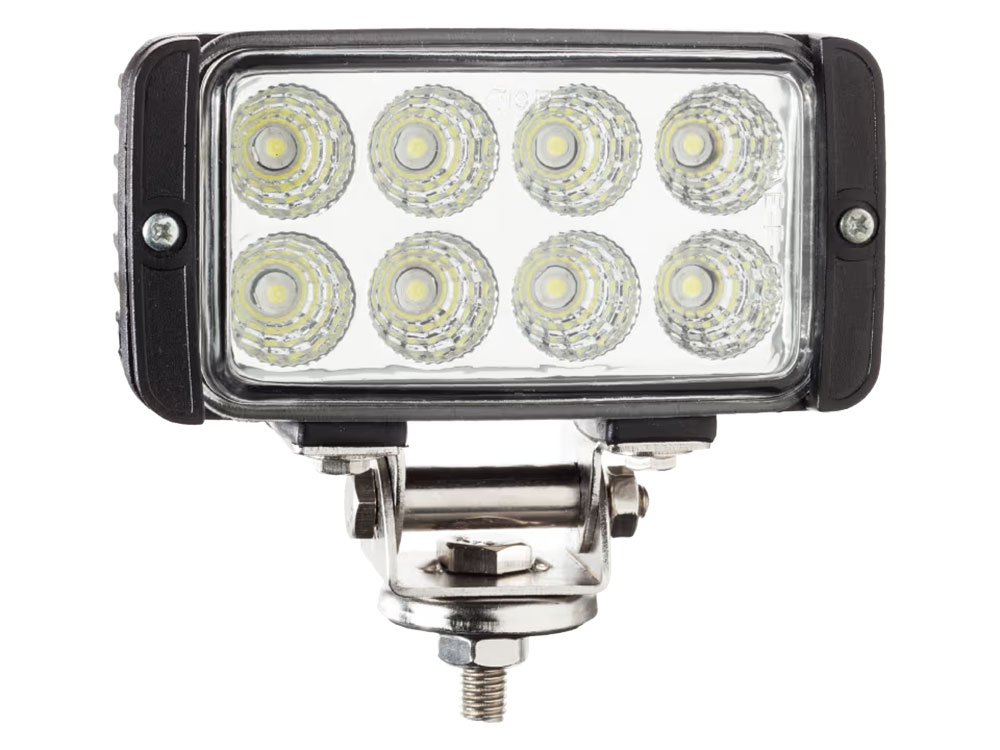
Other great varieties of pontoon boat LED lights include:
- Spreader lights to illuminate where you’re going
- Utility livewell lights
- Tube lights that light the console
Boating’s Top Spotlights for Boaters provides a breakdown of spotlight options for your pontoon boat.
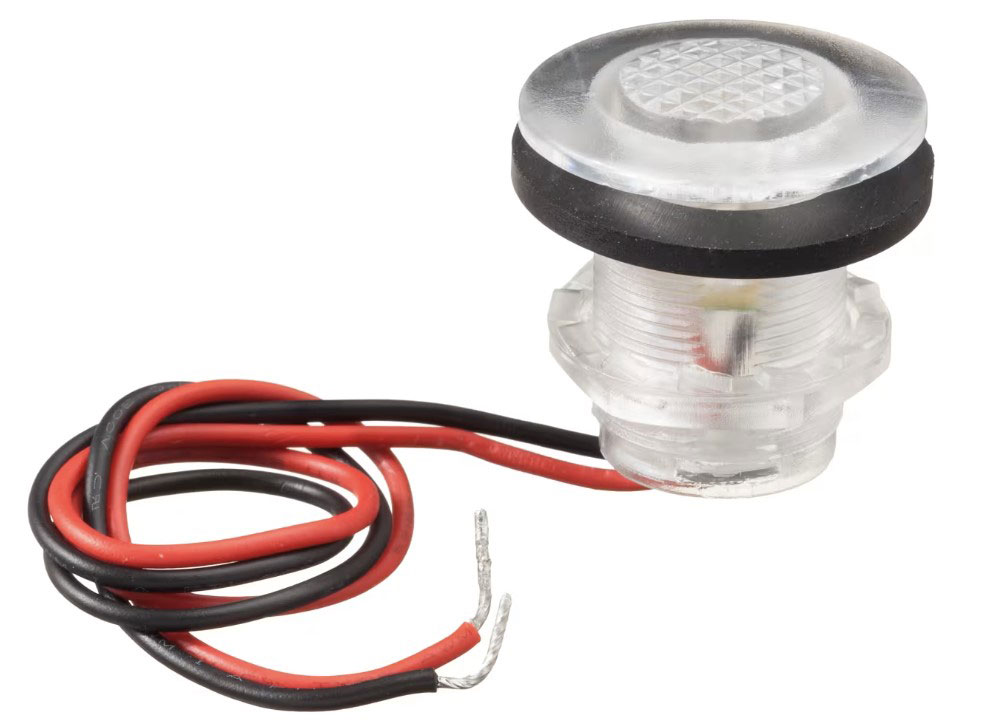
Benefits of LED Lights for Pontoon Boats
LED lights for pontoon boats provide a wide ranging number of benefits. They provide a significant energy savings and produce less heat than other forms of lighting.
The primary benefits include:
- Energy efficiency : LED lights draw less battery power to produce the same number of lumens than do halogen or incandescent lights.
- Longevity and durability : When properly maintained, LED lights last longer and stand up to the elements. If you do need to replace a bulb, they’re more consistent between lights than other types of lighting.
- Brightness and visibility : LED lights produce more light in smaller packages than other types of boat lighting.
- Versatility in color: LED lighting systems allow you to customize the color of your boat’s lighting. You can also control many LED light kits with apps.

Installing Pontoon Boat LED Lights
Just as there are many LED lighting products, you have a range of installation options. Hire a professional, or install them yourself. Integrate all your pontoon boat LED lights into a single circuit, or install and control them individually.
Check out the 2024 Pontoon Boat Buyer’s Guide for some design inspiration. This review of the SunCatcher Elite provides some additional perspective.
Marine Mounting Considerations
Where and how you mount your LED lighting systems depends on your boat’s setup and the look you’re after. You can install a series of individual recessed lights or mount an LED strip on a track .
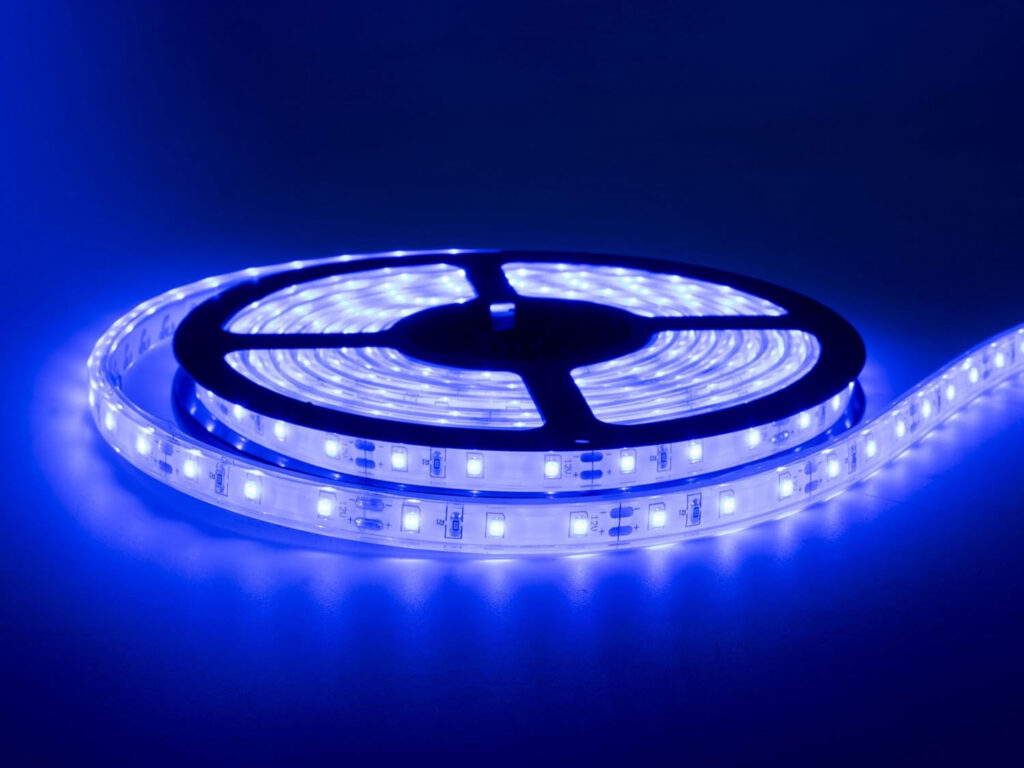
Professional vs. DIY Pontoon Light Installation
Most LED lighting systems are wired into your pontoon boat’s battery system. If you are technical, you may be able to install a new lighting system or modify the one you have.
Professional installation is a great option, too. Professionals understand your boat’s voltage (and can make sure to install the appropriate lights). Most LED manufacturers make them in 12V and 24V options.
How you install LED lights on your pontoon boat also depends on how complex and feature-rich you’d like your system to be. When you start including dimmability and app control, or integrating different LED lighting components, the installation gets more complex.
Maintaining LED Pontoon Lights
When properly maintained, your pontoon boat LED lighting system will last a long time. Clean and dry the lights after use to keep them in ship shape. Make sure that your connections are secure and that the wiring and batteries stay dry.
If you use your pontoon boat in saltwater, take extra care to avoid corrosion. Also, be sure to test your navigation lights before you leave the dock. Being in the middle of the lake at night is no time to find out that your lights are out.
Make a Safe Investment in LED Pontoon Boat Lights
So you’ve got your pontoon boat. You know the many benefits of LED lighting setups. Now it’s time to bring a fully customized, brighter LED setup to the biggest party on the water. Pontoon boats are great. They’re even better with LEDs.
What lights should be on when boating at night?
You’ll need navigation lights (a red and green light on the bow), stern lighting on the back of your boat, a masthead light, and an all-around light. These are the basics, and you can of course add to this.
Where do the lights go on a pontoon boat?
To satisfy the law, you’ll need lights on the bow, on the stern, and atop the console. From there, you could illuminate the deck, any steps, and maybe even beneath the water’s surface under your pontoon boat. Where you place them depends on the design you’re after.
Will lightning strike a pontoon boat?
Any time you are on the water, you should be aware of the weather. If there is lighting in the vicinity, you should consider heading to shore. Lighting can strike boats of all kinds, pontoon boats included.
- More: Affiliate , Gear , Lighting , Pontoon Boats
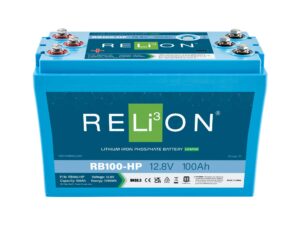
ReLiOn RB100-HP Starting Battery

Boating’s Deals of the Week

What Are the Best Boat Porta Potty Toilets?
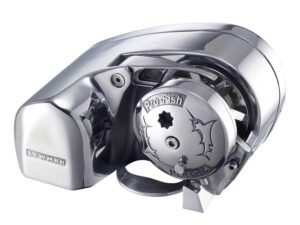
Ultimate Boat Anchor Winch Buyers’ Guide
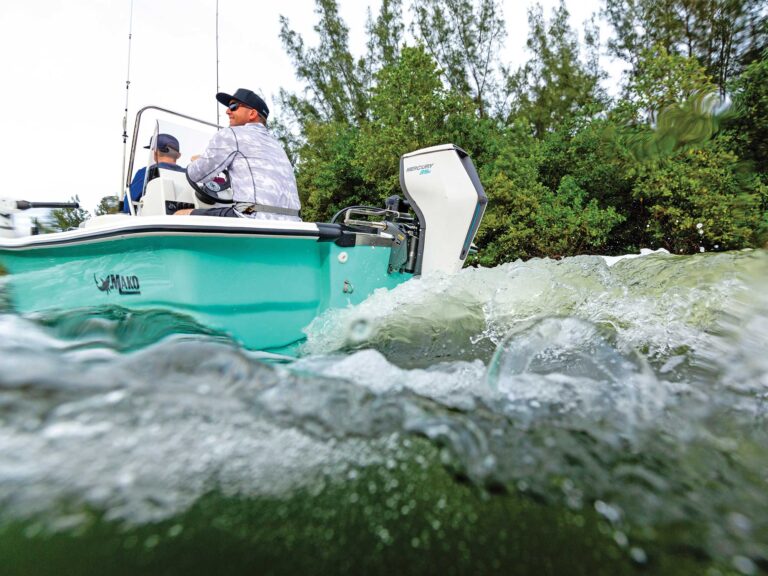
Decoding the Horsepower Ratings of Electric Motors
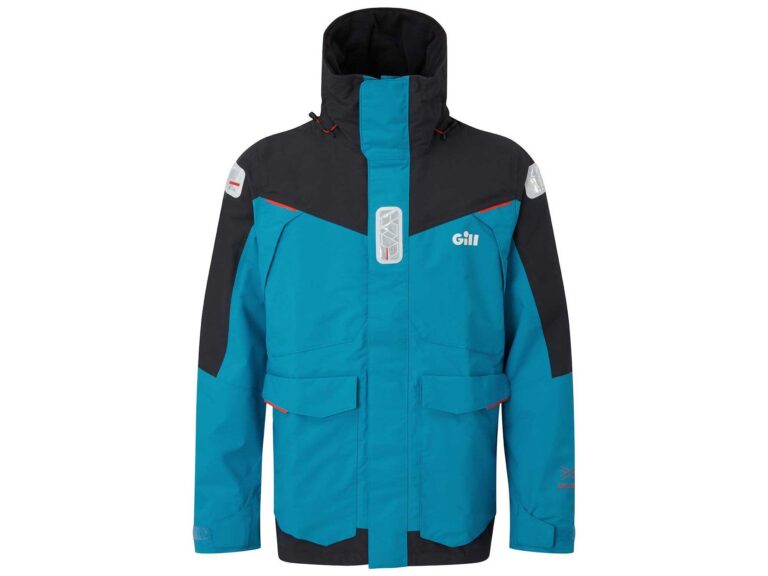
Volvo Penta D6 Diesel DPI

- Digital Edition
- Customer Service
- Privacy Policy
- Terms of Use
- Cruising World
- Sailing World
- Salt Water Sportsman
- Sport Fishing
- Wakeboarding
Many products featured on this site were editorially chosen. Boating may receive financial compensation for products purchased through this site.
Copyright © 2024 Boating Firecrown . All rights reserved. Reproduction in whole or in part without permission is prohibited.

IMAGES
COMMENTS
On any vessel, navigation lights have a specific color, (white, red, green, yellow, blue), arc of illumination, range of visibility, and location, as required by law and regulations. For the purposes of this course, we will concentrate on pleasure boats under 65 feet in length. Knowledge of navigation lights is important to a small-boat skipper ...
The basic rule is that sidelights and a stern light are required. Permissible variations to this rule appear below. Sailboats less than 20m (65.7') can substitute a tricolor light for separate sidelights and stern light—or a bi-color light and a stern light may be substituted. Sailboats less than 7m (23') shall, if practicable, exhibit lights ...
For most small vessels, motoring requires red and green (port and starboard) lights, and a white light visible in all directions around the boat. This is almost always a stern light and a masthead light on sailboats. Boats under sail require port and starboard lights, and a white stern light. Sailboats below sixty-five feet may show a tricolor ...
Powerboat under 23 feet (7m) Powerboats under 23 feet are required to have the following navigation lights displayed: One white masthead light visible for 2 miles. One red & green sidelight visible for 1 mile. One stern light visible for 2 miles. One white, red, green, or yellow all-round light visible for 2 miles.
Updated: November 2, 2017. USCG Required Navigation Lighting West Marine. Powerboats under 12 meters (39.4 feet) in length must have separate or combined red and green sidelights covering 112.5 degrees and visible for 1 nautical mile. The white masthead light must cover 225 degrees, be 1 meter above the sidelights and be visible for 2 nautical ...
A properly lit sailboat at night is a boat that is equipped with the correct navigation lights, which are required by law. These lights must be visible for two miles and should include a green light on the starboard side, a red light on the port side, and a white light aft. Additionally, the boat must also have a white masthead light that is ...
Don't forget to check for site-specific requirements. The lights use a color-coding system for all boats, whether motorized or non-motorized. Even watercraft like jon boats or canoes have obligations to convey their approach on the water. ... Sailboat lights at night are a crucial part of safe navigating when it's too dark to see.
Powered boats under 39.4 feet: One all-around white light, visible from all directions (360 degrees) from two nautical miles away. This light must be attached at least 39 inches above the sidelights. One green starboard and one red port sidelight, visible across 112.5 degrees from one nautical mile away.
As such a power boat, and by extension all sailboats, MUST, without question show one green light on the starboard bow and one red light on the port bow and one all around white light or lights while operating in reduced visibility. These lights should shine at all 360 degrees of visibility with the bow lights shining at an angle of dead ahead ...
Navigating the waters safely requires understanding the critical rules for navigation lights on boats. Boats under power must have red and green side lights and a white stern light visible in all directions. This rule applies to almost any boat you might operate on the water. Knowing and following these navigation light requirements ensures you ...
If less than 65.6 feet long, these vessels must exhibit the lights as shown in Figure 2. The required lights are: Red and green sidelights visible from a distance of at least two miles away—or if less than 39.4 feet long, at least one mile away—on a dark, clear night. A sternlight visible from at least two miles away. Unit 4 of 6. Topic 9 ...
Boats less than 12 meters or 39.4 feet long: You'll need one red light and one green light at the front port and starboard sides of the boat for these boats. These lights should be positioned so that they can be seen at an angle of 112.5 degrees. The sidelights should be strong enough to be seen from a mile away.
The USCG has specific navigation light requirements that all boats need to meet - often depending on the size of the vessel. Read our guide to learn more today. ... NOTE: A sailboat operating under power at night - whether the sails are set, or not - is required to follow the same rules as a power boat, as outlined above, since they are no ...
Boat Navigation Light Rules - Key Takeaways. Colored lights are always denoted as sidelight, Red light on the Port, and Green on the starboard. Red and green sidelights both shine from dead ahead to 112.5° aft (towards the stern) on each side. Stern lights are white and shine towards the stern (aft) and 67.5° forward on both sides.
The table below summarizes the legal requirements for navigation lights on boats in the United States: Boat Size. Required Lights. Under 12 meters (39.4 feet) Red and green sidelights, white masthead light, and stern light. 12 to 20 meters (39.4 to 65.6 feet) Same as above, plus an all-around white light.
The Inland Rules have specific requirements as to anchor lights. That rule is quoted below, as is the USCG site reference. A 360-degree white all-around masthead light with two-mile visibility normally fulfills this requirement for most pleasure boats, but familiarize yourself with and follow the rule. Wire gauge, length of wiring, connections ...
Sailboats are required to have three lights at a minimum: a masthead light, a red port light, and a green starboard light. The masthead light is white and is located at the top of the mast. This light should shine forward and aft and be visible from 2 nautical miles away. It is important to ensure that the masthead light is not obstructed by ...
Red and green sidelights, one sternlight, and two all-round lights in a vertical line (upper red, lower green) also meet the navigation lights requirement for sailboats that are not operating under engine power (Rule 25). One combination red, green, and white light exhibited near the top of the mast meets the navigation lights requirement for ...
Vessels at Anchor. When a vessel is anchored at night outside a designated anchorage, an all-around light visible from at least 2m is required. During the day, an anchored vessel must display a black anchor ball. Minimum Visibility Range. Boats less than 12m (39.4'), sidelights are required to be visible for at least 1nm.
Two multiple bulb LED fixtures: Portable multiple bulb LED fixtures for both the bow and stern light - NaviLight, bi-color $49.99, white $49.99*. Portable Navigation Lights for small boats less than 7 knots - Aqua Signal, bi-color $34.99, white $34.99**. *NaviLight portable lights require 3 "AAA" batteries.
These lights must be displayed when boating at night or in reduced visibility conditions. Canadian boating regulations have specific navigation light requirements for different types and sizes of vessels. The most common types of navigation lights required. All-round light: a light that shines continuously and can be seen all the way around the ...
Navigation light requirements by boat type and length. As a boater, you should always double-check to ensure that you have the proper navigation lighting for safe and legal boating. Here are the various requirements for each type and length of boat: ... 1 all-round white light at night or 1 ball during the day, and; An additional all-round ...
When sailing at night, you'll need three types of lights, green, red and white. The green light should be on the starboard (right), the red light on the port side (left), while the white light is to be placed at the front, rear, and top of the boat. All these lights should be visible on a dark and clear night.
The requirements include the number of lights, angle of light emitted, and visible range of the light. At its most basic, your pontoon boat needs the following: Masthead lights: These are typically white lights that are mounted in a place that is visible to other boats. This base-mounted, fold down LED pole light is a great example. Navigation ...